Archived Water Damage Blog Posts
Water Damage Restoration for NRH Commercial Properties
7/1/2024 (Permalink)
North Richland Hills is renowned for its bustling commercial landscape and rapid economic growth, but it also faces unique challenges when it comes to water damage. From severe storms to plumbing failures, water-related emergencies can disrupt operations and threaten the integrity of commercial properties. In such critical moments, prompt and effective restoration services are essential to minimize downtime, protect assets, and restore business continuity.
Understanding Water Damage in North Richland Hills
NRH experiences a semi-arid climate with hot summers and occasional severe weather events, including thunderstorms and flash floods. These weather conditions heighten the risk of water damage incidents such as flooding, roof leaks, and burst pipes, which can compromise the structural integrity and functionality of commercial buildings.
The Importance of Professional Water Damage Restoration Services
For commercial property owners in NRH, professional water damage restoration services are indispensable in mitigating the impact of water emergencies. Companies like SERVPRO of North Richland hills specialize in rapid response and comprehensive restoration solutions tailored to commercial properties. Swift action is crucial to minimize financial losses, preserve valuable inventory and equipment, and maintain a safe working environment for employees and customers.
Water Damage Services Offered
Commercial water damage restoration services in NRH encompass a wide array of essential tasks to expedite recovery and ensure minimal disruption to business operations:
- Emergency Response: Rapid deployment of experienced technicians equipped with state-of-the-art water extraction and drying equipment to mitigate damage and prevent further deterioration. SERVPRO of NRH crews typically dispatch in less than two hours.
- Water Extraction and Drying: Quick removal of standing water followed by thorough drying and dehumidification of affected areas to prevent mold growth and structural damage. SERVPRO of NRH uses industrial grade water extraction pumps, air movers, and dehumidifiers.
- Content Cleaning and Restoration: Specialized cleaning and restoration of furnishings, equipment, and inventory affected by water damage to salvage valuable assets. SERVPRO of NRH uses ultrasonic and Esporta Wash System cleaning techniques.
- Structural Repairs and Reconstruction: Comprehensive repair and reconstruction services to restore damaged structures and facilities to preloss conditions, minimizing downtime and restoring business continuity.
- Mold Remediation: Inspection, assessment, and professional remediation of mold growth resulting from water damage, ensuring a safe and healthy environment for employees and customers. SERVPRO of NRH is a Texas-licensed mold remediation contractor.
Benefits of Professional Damage Restoration Services
Choosing professional restoration services for commercial properties in NRH offers several key advantages:
- Minimized Downtime: Prompt water damage restoration services help expedite recovery and reduce operational downtime, allowing businesses to resume normal operations quickly.
- Compliance and Safety: Restoration professionals adhere to industry standards and safety protocols, ensuring compliance with health and safety regulations while minimizing liability risks. SERVPRO of NRH follows IICRC standards, the industry’s leading top-quality standard.
- Insurance Coordination: SERVPRO of NRH’s administrators work closely with insurance providers to facilitate claims processing and maximize coverage for water damage restoration expenses. We process hundreds of insurance claims for our customers every year.
- Preservation of Reputation: Protecting the integrity and appearance of commercial properties through timely restoration helps maintain a positive reputation among clients, tenants, and stakeholders.
Call SERVPRO of NRH for 24/7 Water Damage Dispatch
SERVPRO of NRH is always available to commercial property owners. Call us anytime for immediate water damage restoration assistance. We’re Here to Help.
What is Water Damage?
4/24/2023 (Permalink)
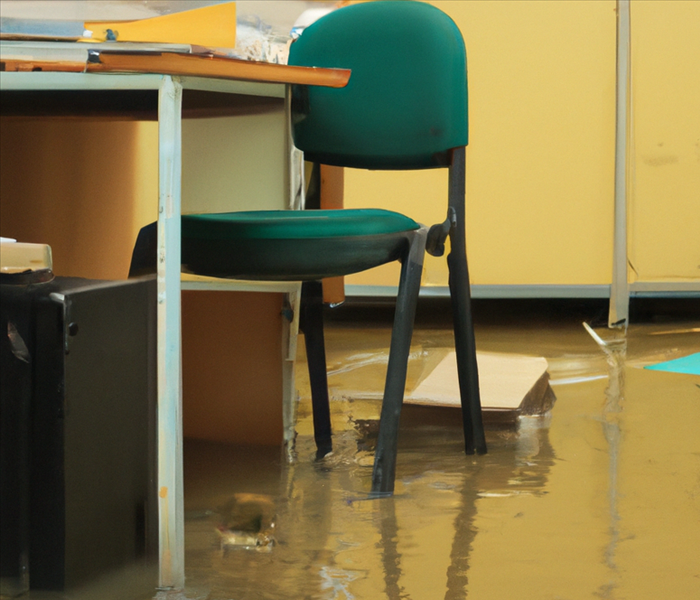 SERVPRO of North Richland Hills dispatches technicians 24 hours a day to every size of water damage emergency.
SERVPRO of North Richland Hills dispatches technicians 24 hours a day to every size of water damage emergency.
Water Damage Definition
Water damage is a term used to describe any harm resulting from water flow into a structure. Water damage is a common issue caused by a variety of events, such as:
- Malfunctioning pipes or pipe bursts
- Heavy rainfall or flooding
- Faulty home appliances and plumbing fixtures
- Damaged or leaking roofs
- Restricted drainage systems
- Sewage backups
- Cracks and leaks within the foundation
- Humidity & condensation
Water damage restoration is a necessary measure that homeowners and property owners may initiate when facing water damage consequences. Water damage claims are the second highest among insurance claims filed in the United States, accounting for 20% of all claims, per the Insurance Information Institute.
Consider our top five damage prevention tips to help prevent water damage in your home.
Top 5 Water Damage Prevention Tips
- Keep a strong foundation along with sealed doors and windows.
Homeowners can prevent water damage by inspecting their foundation for vulnerabilities in windows, doors, or other areas prone to water damage. Indicators such as cracking walls or floors, sloping or uneven floors, and widening gaps signal foundation issues. Signs like water or moisture collection, drafts, or increased energy bills can detect a leak in a window or door.
Downspouts should be directed away from the house to avert water damage. During rainfall, gutters accumulate water from the roof and channel it into downspouts. If downspouts are not connected to proper drainage or oriented toward the house's foundation, water seepage into the soil may weaken the foundation. In addition, excess water may cause soil erosion, weakening the foundation's stability over time.
2. Direct downspouts away from your property.
Redirecting downspouts away from the house is a practical measure that thwarts water damage and safeguards one's valuable investment. This technique guarantees durability and precludes soil erosion in regions with abundant rainfall. Excess water may cause damage to a home's foundation, leading to costly repairs and decreased property value.
Homeowners can protect their investment by verifying downspouts are correctly installed and functionary. Even small amounts of water that seep into the foundation can cause damage.
3. Install shut-off valves.
An automatic shut-off valve fitted on a washing machine is engineered to diagnose water leaks and automatically discontinue the water supply, mitigating considerable damage. For this purpose, this valve is commonly installed at the washing machine water hose connection points, which are at risk of leaks or burst hoses due to constant use. This mechanism is also viable for dishwashers, ensuring water leakage is detected promptly, averting profound residential damages.
4. Install sump pumps.
A sump pump is an instrument designed to prevent water damage in the basement or crawlspace of a house. Typically installed in a sump basin, water flows into the pump naturally or through a drainage system. Once the water level reaches the set point, the sump pump removes it and disposes of it through a designated drainage system.
Installing a sump pump in areas with high water tables or frequent flooding is advisable. Rainfall, melting snow, or other sources may cause severe damage to the house's foundation, mold growth, and related health concerns.
With varying power sources available – electric or battery backup – sump pumps typically have alarms or sensors that alert homeowners to potential problems with the pump or flooding events. Homeowners looking to protect their properties from water damage should consider the long-term benefits of investing in a sump pump. The instrument saves extensive repair costs and ensures the durability of a building's foundation and structural elements.
5. Check appliances that use water, plus tubs, sinks, and showers, for leaks regularly.
If you believe your toilet, sink, shower, or tub might leak, it's crucial to watch for various signs. You may observe water pooling around the base or on the adjacent floor, which could signal a leakage. Additionally, if your water bill suddenly shoots up without explanation, it often indicates a leak somewhere in your home, with the tub being a possible suspect.
Multiple factors contribute to the leaking of a tub. One prevalent issue is poor caulking around the base of the tub. Caulking dries out and cracks over time, allowing water seepage and resulting in leaks. Another possible cause for leaks is the overflow gasket in the tub's overflow drain. If this gasket becomes loose or deteriorates, it can lead to leakage.
Timely resolution of leaks is critical to prevent further damage to your home. Over time, undetected water can seep into walls and flooring, leading to structural damage and mold growth. It's advisable to have a certified plumber thoroughly examine your plumbing system for leaks and conduct prompt repairs where necessary. In the meantime, wipe surfaces around your tub dry after use and stay alert to any signs of moisture or leaks.
Calling a Water Damage Restoration Company When Prevention Fails
Even the best-kept property experience water damage. When this happens, a water damage restoration company is the right first call t make. Damage restoration companies are professional entities specializing in repairing and restoring water-damaged properties.
Skilled and trained technicians assess and mitigate water damage to reinstate the property to its pre-damage condition. They employ advanced restoration techniques encompassing water extraction, drying, dehumidification, mold remediation, structural drying, sanitation, and damage repair services. Ideally, water damage restoration services are started within 24-48 hours of water damage occurrence to mitigate further damage and minimize restoration expenses.
The collaboration between water damage restoration companies and insurance providers facilitates a seamless claims process, including providing damage documentation, working with adjusters, and providing estimates for repairs and restoration.
Selecting an accredited water damage restoration company is imperative, as they hold experience, expertise, licensing, and certification from reputable industry organizations like the Institute of Inspection, Cleaning, and Restoration Certification (IICRC).
What is SERVPRO?
SERVPRO remains a renowned and trusted commercial water damage restoration company with over 50 years of industry experience.
SERVPRO offers extensive professional services, including water damage restoration, fire damage restoration, mold remediation, and related services, with a workforce of over 1800 franchised entities across the US and Canada. Certified SERVPRO technicians undergo rigorous training programs from SERVPRO University and possess certifications from reputable institutions like the IICRC, making them the preferred choice for property owners or businesses requiring water restoration services.
SERVPRO offers comprehensive water damage restoration services, encompassing every stage, from assessment and mitigation to repair and rebuilding. With their 24/7 emergency response, they minimize damage and overall costs associated with water damage. Additionally, they collaborate with major insurance companies to facilitate claims and optimize client coverage.
SERVPRO of North Richland Hills's Water Damage Team
Calling SERVPRO of North Richland Hills brings several advantages when dealing with water damage restoration.
- Nearly 40 years of experience from a family-owned and operated franchise. We are one of the longest-tenured SERVPRO franchisees in the nation.
- We offer full-service restoration. We do it all--cleaning, restoration, and construction.
- We accept all insurance claims. And we will assign a dedicated Project Coordinator to walk you through every step of your insurance claim.
SERVPRO technicians have the specialized equipment and technical expertise necessary to effectively evaluate the extent of the damage and develop a comprehensive restoration plan, leading to efficient and effective restoration, often preventing further damage such as mold growth.
Safety is crucial at SERVPRO of North Richland Hills; our technicians prioritize safety during water-related events, ensuring your property and occupants remain safe. EPA-registered disinfectant ensures that affected areas are effectively and safely cleaned and disinfected, leaving no harmful contaminants behind.
In addition to our restoration services, SERVPRO of North Richland Hills also offers construction services. Any necessary repairs to structures or systems are completed quickly and efficiently, reducing the time the property is open to vulnerabilities.
SERVPRO of North Richland Hills provides comprehensive documentation detailing all findings and takes detailed photographs of the affected items and rooms to validate the claim with your insurance adjuster; prompt and fair compensation for any losses is ensured.
Contact SERVPRO of North Richland Hills. Our team is always ready and committed to providing the best professional water damage restoration services.
4 Silent Signs of Water Damage in Your Home
3/15/2022 (Permalink)
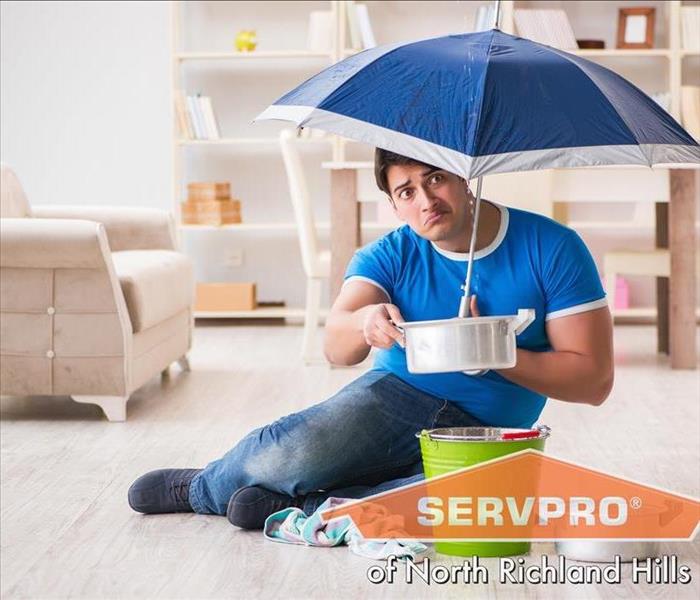 If your property has sustained water damage due to a leaking pipe, a natural disaster, or any other event, connect with SERVPRO ASAP.
If your property has sustained water damage due to a leaking pipe, a natural disaster, or any other event, connect with SERVPRO ASAP.
Water damage can be a significant safety concern as it can endanger the structural integrity of a house. That is why it is essential to spot water damage symptoms before they turn into a big and expensive problem.
While the damage might be slow and silent, there are some signs that can clearly indicate water damage. Let's explore these indicators in further detail.
#1. Changes to Floors, Walls, or Ceilings
Peeling and bubbling wallpaper or paint are among the earliest signs of water damage. Paint and wallpaper can also start to bloat and warp as time passes. But if you still leave the cause of water damage untreated, it could become more severe than just crooked wallpaper patterns.
In some cases, walls and ceilings may get so soaked with water that if you touch them, you may find them spongy to the touch. If this occurs, the wall is at risk of collapsing.
Additionally, water can start seeping into the subfloor, which changes how your floor usually looks. The leaking pipes may saturate your foundation and alter the floor's structure.
Once you've had the water damaged repaired, there are several prevention tips to follow to ensure it doesn't happen again.
#2. Musty Odors in the House
You might notice a pungent must, moldy, or stale smell in parts of your home that are sustaining water damage out of your sight. Musty odors with no discernable source are a strong indicator of a water leak somewhere in your house.
Usually, this smell occurs from mildews, which cause a horrible smell as they build up and release foul gas. Moreover, humid air could also be a potential cause of the musty smell.
Only fixing the water damage can help you remove the mold and the musty smell altogether. That way, your home will begin to smell fresh again.
#3. Visible Stains and Discolorations
Visible stains and discolorations on walls, ceilings, or floors are another significant indicator of hidden leaks.
You might even catch sight of grayish lines on walls, brown rings on ceilings and floors, and other discolored areas. It is essential to inspect appropriately to ensure that the problem is resolved before further structural damage occurs.
Our technicians of SERVPRO of North Richland Hills can assist in pinpointing the exact source of the leak and fixing it quickly.
#4. Sagging Ceilings and Walls
Another way to recognize water damage is when the ceilings and walls start sagging. This is an incredibly dangerous sign of water damage. When the water saturates ceiling material or drywall, the weight of the soaked materials ends up weakening the materials and they could collapse.
The water leak might not even be severe. Sometimes minor leaks can cause the wall to swell and bow over time.
Hire Us to Restore Your House and Fix Water Damage
If your property has sustained water damage due to a leaking pipe, a natural disaster, or any other event, connect with SERVPRO ASAP. We can help repair any leaky pipe through our exceptional Fort Worth Water Damage Restoration services.
Connect with us online or call our North Richland Hills franchise at (817) 589-1499. We’re available 24/7 for your immediate needs.
Top 5 Mistakes to Avoid when Using Humidifiers
2/10/2022 (Permalink)
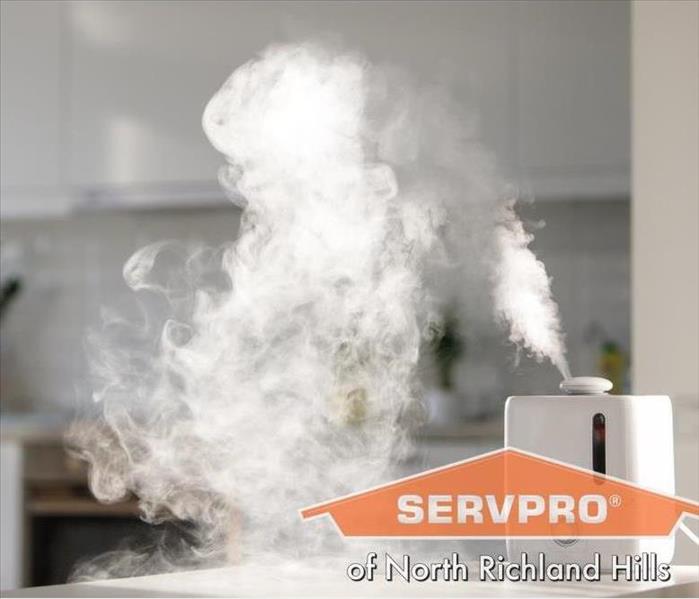 A high level of water vapor in the air can create the perfect environment for mold spores to multiply.
A high level of water vapor in the air can create the perfect environment for mold spores to multiply.
Humidifiers are helpful appliances to increase moisture levels in the air. Household air is typically extremely dry and cranking up the heating in winter reduces humidity even more. Many people like to increase indoor humidity levels if they suffer from allergies, dry coughs, dry skin, or have flu symptoms. In addition, water vapor from humidifiers creates a suitable indoor environment if you care for many tropical houseplants.
However, humidifiers are only good if you use them properly. Unfortunately, common mistakes when using humidifiers can cause issues. For example, stagnant water can develop bacterial growths, and overly humid environments can cause mold in rooms.
Mistake #1: Not Changing Water Often Enough
It’s a mistake to leave water in a humidifier for too long. Stagnant water can become breeding grounds for mold and bacteria. This means that dirty water could release toxins into the air the next time you use the steam unit. To avoid this mistake, always empty the unit after use.
Mistake #2: Not Paying Attention to Humidity Levels
When using a humidifier, don’t make the mistake of ignoring relative household humidity levels. The Environmental Protection Agency (EPA) recommends the ideal humidity level is between 30 and 50 percent. So, before switching on a humidifier, use a humidity meter to ensure the air is not too dry or too damp.
Mistake #3: Using Tap Water in a Humidifier
Some humidifiers like ultrasonic humidifiers require using purified or distilled water in the unit. For example, using tap water to humidify a room could create white dust from the mineral particles in the water. This dirty mist can clog filters and cause a white film to form on furniture.
Mistake #4: Not Cleaning the Humidifier Often
A common mistake is to forget to clean the humidifier. Admittedly, cleaning the enclosed tank can be a chore. However, doctors from the Mayo Clinic say that a dirty unit allows allergens, mildew, mold, and bacteria to accumulate. Therefore, the recommendation is to clean the unit weekly. After cleaning, rinse it with water to remove any chemical residue.
Mistake #5: Not Placing a Humidifier on a Flat Surface
Placing your humidifier on an even surface is essential because it could easily tip over and spill. A humidifier only works efficiently when the unit is placed correctly on a raised, flat, stable surface.
One issue when using a room humidifier is that it can encourage mold growth. A high level of water vapor in the air can create the perfect environment for mold spores to multiply. The result is musty air and unsightly black patches on carpets, walls, floors, and upholstery.
What should you do if you notice mold growth in your home? It’s vital to act without delay to remove the mold and the cause of excess household humidity or moisture. Contact SERVPRO at (817) 589-1499 to learn about our Fort Worth mold remediation services.
How to Prevent Damage from Frozen Pipes
2/10/2022 (Permalink)
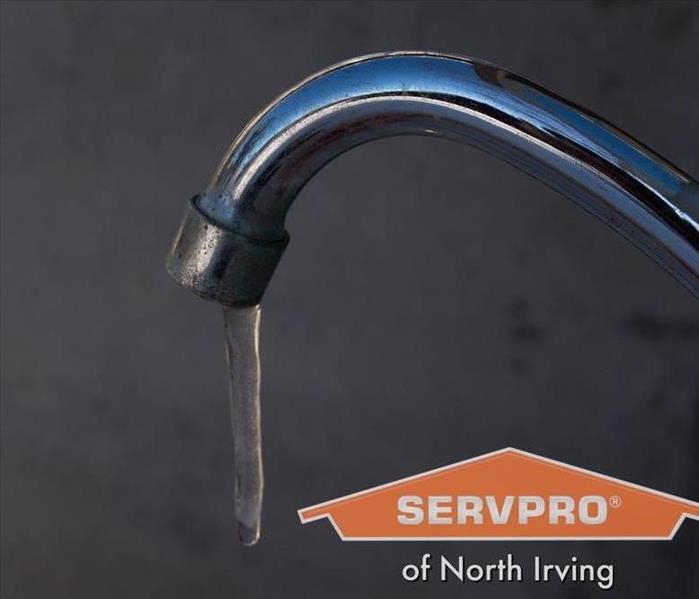 After stopping the water flow, it’s vital to call in water damage restoration experts.
After stopping the water flow, it’s vital to call in water damage restoration experts.
Frozen water pipes can cause disruption to your household and a tremendous amount of damage. Apart from blocking the water flow, a frozen pipe can burst when the ice blockage thaws. This can spew gallons of water into your home, resulting in extensive water damage. In addition, if you ignore water damage restoration, you could face severe mold problems in your home.
The Environmental Protection Agency (EPA) recommends hiring a water damage restoration professional who can also deal with mold remediation.
There are several steps you can take to prevent damage from frozen pipes. First, it’s a good idea to learn what happens when water freezes in a pipe. Then you should take steps to prevent water pipes from freezing. And lastly, it’s necessary to know how to thaw a frozen water line safely.
Simple Ways to Prevent Damage from Frozen Pipes
Here are some ways to avoid property damage that can occur if plumbing pipes freeze in winter.
1. Identify Pipes at Risk of Freezing
The most common pipes that freeze when temperature plummets are outdoor hose bibs, water sprinkler lines, and swimming pool supply lines. Indoors, uninsulated water pipes in basements, attics, crawl spaces, and garages are also at risk of freezing.
When the water in pipes freezes, two things can cause them to burst. First, water expands when it turns to ice, and this can cause cracks in plastic and metal piping. Second, pressure on pipes builds behind the blockage.
2. Insulate Water Supply Lines and Indoor Spaces
The best way to prevent plumbing damage from frozen lines is to insulate hot and cold water pipes. Pipe insulation is relatively inexpensive compared to paying for costly water damage restoration. In addition, it’s crucial to add insulation to basements, crawl spaces, and attics.
Not only will insulation prevent pipes from freezing, but you will save money on energy costs.
3. Drain Outdoor Supply Lines During Winter
A simple way to prevent outdoor pipes from freezing is to drain water from them. First, close the supply valve to sprinkler systems, garden hoses, and hose bibs. Then open the bibs to let water drain.
4. Take Steps to Prevent Frozen Pipes
During a particularly cold snap, it’s vital to ensure indoor areas are warm enough. Keep the thermostat at least 65°F day and night. It is also a good idea to open internal doors and kitchen and bathroom cabinet doors. This allows warmer air to circulate throughout the house and keep pipes warm.
Another handy tip to prevent pipes from freezing is to run a trickle of water from faucets when there is a risk of a hard freeze.
5. Learn How to Unfreeze Pipes
If a water pipe freezes, it’s vital to thaw the ice blockage gently to prevent extensive damage. Here is what to do:
- Shut off the main supply of water
- Open the faucet to allow the thawing water to flow freely.
- Locate the frozen section of the pipe.
- Apply heat using a hair dryer, electric heating pad, or portable space heater.
- Continue applying gentle heat until regular water pressure returns.
What happens if the pipe bursts and causes a flood? After stopping the water flow, it’s vital to call in water damage restoration experts. In Dallas, SERVPRO has years of experience restoring properties after a flood. Contact us today at (817) 589-1499 to find out about our Fort Worth water damage restoration services.
Three Myths About Water Damage Cleanup in Fort Worth
1/6/2022 (Permalink)
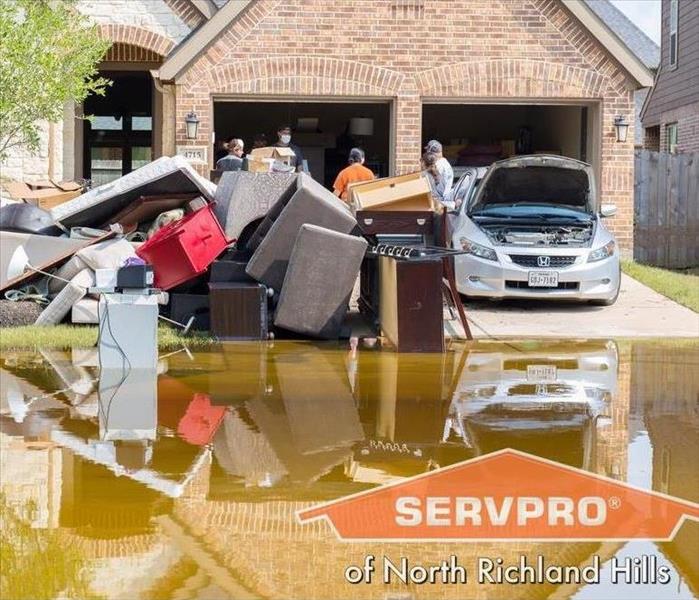 If you find yourself in need of professional Fort Worth water damage restoration services, then look no further than SERVPRO.
If you find yourself in need of professional Fort Worth water damage restoration services, then look no further than SERVPRO.
Homeowners can save about 10 percent on their water bills when they quickly fix water leaks. But fixing the leak is one thing. Often, the bigger issue is the water damage left behind.
Regardless of the severity of the water damage, you should always call for local Fort Worth water damage restoration services. SERVPRO will ensure that your property is quickly restored, fresh-smelling, and mold-free after a plumbing leak.
Below are three myths about water damage cleanup you should know.
Myth #1: You Can DIY It
DIY has become a popular solution for many issues today, the main reason being that people can easily save money just by doing it themselves. The problem with this, however, is that DIY-ing can’t solve all issues. In fact, trying to DIY something can often make water damage worse.
In the case of water damage, trying to perform restoration yourself will only cause further problems. For this reason, it’s always highly recommended that you hire professional Fort Worth water damage restoration services.
Myth #2: It’s No Big Deal
Many people tend to think that water damage is only a matter of just drying up the moisture and the problem is resolved. Truth be told, there are deeper problems with water damage that most property owners don’t realize.
When water damage occurs, dehumidification will be needed to completely dry the area. And this can only be done with state-of-the-art equipment that most professional services carry. Also, knowing what is salvageable is something that only the experts can determine.
Without professional help, your property can suffer from mold growth and structural collapse. Fort Worth water damage restoration services will ensure that no such issues persist.
Myth #3: Insurance Won’t Cover It
In most cases, property owners think because their water damage is minor, the insurance company won’t help pay for the damages. This, however, is not always true as your insurance company may decide to cover all damages.
Each situation is different, though, and your provider won’t always offer coverage for all damages. SERVPRO will work with your insurance provider to make sure you save as much as possible on water damage restoration.
What You Should Do Instead
Given the information above, if water damage has occurred on your property, don’t hesitate at all in contacting Fort Worth water damage restoration services.
Such services have industry experts who are trained to restore salvageable items and areas of a property that were afflicted with water damage.
Get Water Damage Restoration From SERVPRO Today
If you find yourself in need of professional Fort Worth water damage restoration services, then look no further than SERVPRO. With our 35+ years of experience, we feel confident we can help you.
For any inquiries, call us at (817) 589-1499. Or visit our contact page.
Common Sump Pump Problems Homeowners Face
12/9/2021 (Permalink)
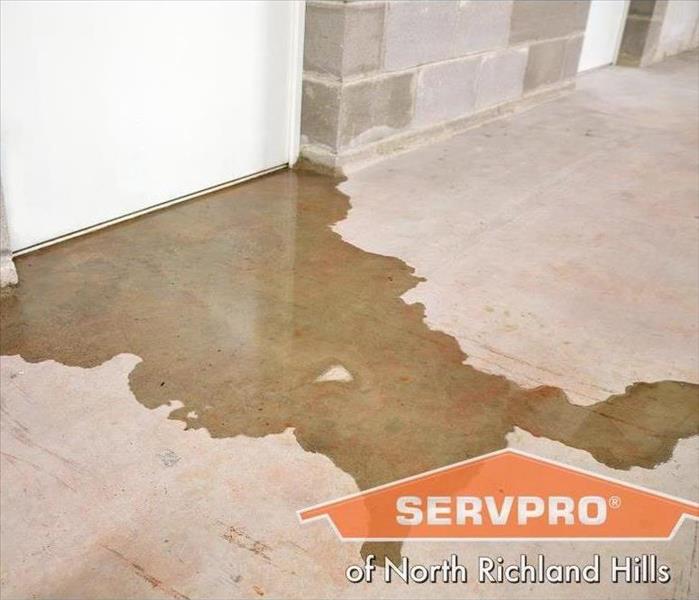 With the dangers that can happen with a broken sump pump, it’s very likely that water damage will occur in your home.
With the dangers that can happen with a broken sump pump, it’s very likely that water damage will occur in your home.
Between 1996 to 1999, 99% of US counties suffered a flooding event. In Fort Worth, Texas alone, nearly 600 flooding events have devastated the city during this time period. While sump pumps in homes have helped to ease the issue of basement floods, some homeowners were likely burdened with common issues pertaining to sump pump problems.
Sump pumps serve as the first line of defense against basement floods. But if they have faulty functioning, then you might end up with a destroyed basement that will require Fort Worth water damage restoration.
To get familiar with common sump pump problems, continue reading below.
Why do Sump Pumps Fail?
Before you learn about the common sump pump problems, it’s important you understand why your sump pump is failing to begin with.
Sump pumps are composed of many intricate parts that are prone to malfunctioning. And because there are many different models and types sold on the market, it’s probable that you will own one that’s cheaply made. Also, besides use and brand type, improper installation can also cause a sump pump to break.
So What Are the Common Sump Pump Problems?
There are quite a few common issues that can occur with sump pumps. They include:
Overwhelmed Pumps
No matter their design, a single sump pump is not powerful enough to take on a flooded basement. Because of this, they can be overwhelmed due to the large amounts of water pouring in.
No Water Entering the Pump
If your sump pump isn’t taking in any water, this is often a sign that your pump wasn’t installed correctly. Or it can even be because your sump pump isn’t linked to a drainage system.
Clogged Pump
It’s important that your sump pump has a lid. Without one, it will become clogged and dirty over time. Eventually, your pump will become slow or it will stop working entirely.
Power Loss
A sump pump that loses power can leave your basement vulnerable.
When a powerful rainstorm happens, it has the potential to knock down power lines. As a result, your home loses power and your sump pump will not function.
Sump Pump is Continuously Running
If your sump pump is running too much, no matter how harsh the weather, you should consider hiring a professional right away for assistance. An overworked pump can burn out due to consistent flooding or because of a broken or missing valve.
Frozen or Clogged Discharge Lines
Discharge lines are what allow a sump pump to function properly as they dispel collected water. When these lines are frozen or clogged, your pump’s system will begin failing.
Call SERVPRO for Our Fort Worth Water Damage Restoration Services
With the dangers that can happen with a broken sump pump, it’s very likely that water damage will occur in your home. But don’t worry, SERVPRO is more than happy to provide its Fort Worth water damage restoration services. With our 35+ years of experience, we feel more than confident that we can help you.
Call us today at (817) 589-1499. Or fill out our online form.
Hurricane Categories and Disaster Restoration in Fort Worth
6/28/2021 (Permalink)
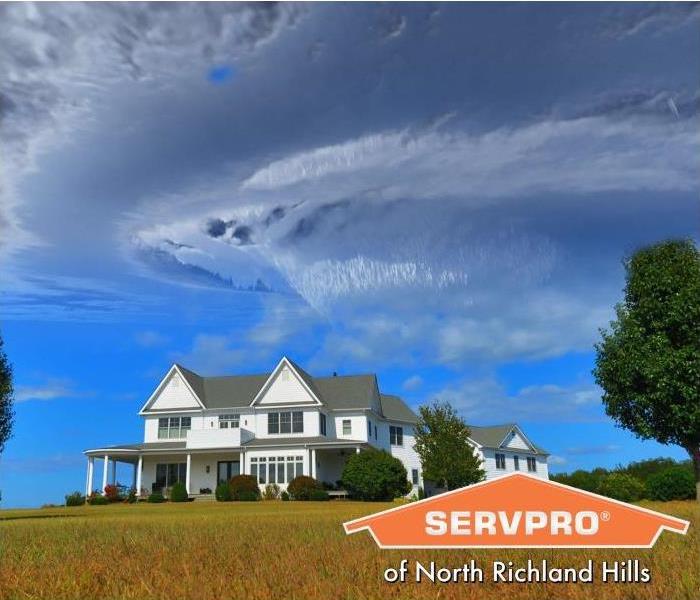 If your home or commercial building sustains water damage during hurricane-induced flooding, we’re here to help.
If your home or commercial building sustains water damage during hurricane-induced flooding, we’re here to help.
Fortunately, Fort Worth is in a low-risk zone for hurricanes, but they do still occur. Knowing the different hurricane categories can inform your disaster restoration needs.
At SERVPRO in North Richland Hills, we’ve been restoring flood and hurricane-damaged properties in the area for decades. Contact us today at (817) 589-1499 for a free estimate on our disaster restoration services.
How are Hurricanes Categorized?
In 1971, civil engineer Herbert Saffir and meteorologist Robert Simpson developed the Saffir-Simpson Hurricane Wind Scale. The scale acts as a rating system and establishes five categories of hurricane strength based on sustained wind speed.
How is the Saffir-Simpson Scale used?
Meteorologists use the scale to estimate how much impact the hurricane will have on a given area and the type of damage likely to occur from it. The rating system gives meteorologists examples of damage that can occur from different wind intensities.
Do the Different Hurricane Categories Estimate Flood Damage?
The Saffir-Simpson Scale only estimates damage from wind intensity. The hurricane categories do not assess things like flood damage or storm surges.
What the Hurricane Categories Mean
Category 1 Hurricanes
A Category 1 hurricane has wind speeds between 74 and 95 mph and will cause minor damage to roofs, gutters, and siding of frame houses. Small trees can be uprooted, and tree branches snapped.
Power outages are also common in this hurricane category. Falling debris can lead to injuries, and unanchored mobile homes are at risk of toppling. Coastal flooding is also a risk in Category 1 hurricanes.
Category 2 Hurricanes
In a category 2 hurricane, all the damage present in a Category 1 hurricane applies, but the damage is more extensive. Serious injury is also a risk, and flooding in low-lying areas is likely to occur.
Category 3 Hurricanes
Wind speeds measure 111 to 129 mph, with significant property damage and injuries to people and animals present in a Category 3 hurricane. Sometimes, a total loss of power for several weeks can result. Safe drinking water is often hard to find, and available water is usually contaminated after these storms hit.
Category 4 Hurricanes
Even homes built to withstand a hurricane can be severely damaged in a Category 4 storm. Category 4 hurricanes have wind speeds from 130 to 156 mph. Significant flooding, water damage, power outages, and road blockages are commonplace in Category 4. Mobile homes and poorly built structures can collapse.
Category 5 Hurricanes
These storms are the most powerful and destructive on the Saffir-Simpson scale. In a Category 5 storm, wind speeds are 157 mph or above. Significant life loss and property damage often result in a Category 5 hurricane.
Roofs fail, and walls collapse, with most buildings entirely destroyed. Water shortages and power outages can last for months after the storm passes.
Hurricane Disaster Restoration
Even a Category 1 hurricane can result in severe damage and flooding to structures. If your home or commercial building sustains water damage during hurricane-induced flooding, we’re here to help.
Contact us 24/7 for a free estimate on our hurricane disaster restoration services.
24/7 Emergency Water Damage Restoration Services in Fort Worth
4/5/2021 (Permalink)
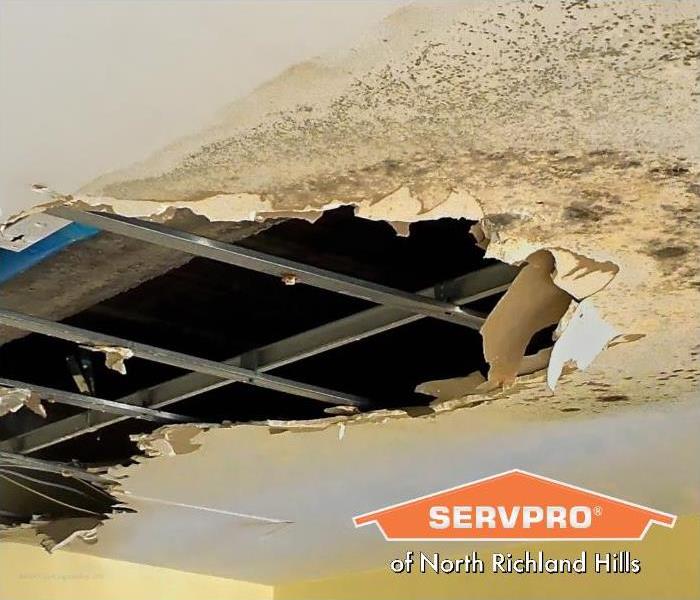 Recieve 24/7 service with our Fort Worth team of experienced professionals. We will restore and repair water damage so you're back to normal ASAP!
Recieve 24/7 service with our Fort Worth team of experienced professionals. We will restore and repair water damage so you're back to normal ASAP!
Being in the restoration business for over 30 years, we’ve seen every kind of water damage you can imagine. Any space can become flooded within minutes, and there is only so much recovery you can do with a mop and bucket.
If you encounter water damage to your property we have one very important piece of advice: act quickly. The longer you wait, the more likely it is that secondary damage will develop such as toxic mold growth.
Your Fort Worth SERVPRO is here to restore any size property to its original clean and dry condition.
Water Damage Timeline
How soon does damage happen after contact with water and moisture? It progresses faster than you may think.
Within The First Few Minutes
Water rushes through the space and rapidly saturates everything. Walls, flooring, upholstery, photos, documents, and personal belongings are now soaked and incur minor to severe damage.
Within 24 Hours
Water seems harmless most of the time, but it can severely damage things within a 24-hour cycle.
- Construction materials like drywall swell and deteriorate.
- Metal surfaces and electronics are altered.
- Wooden furniture swells and may crack.
- Dyes and inks on cloth or paper bleed and stain.
Between 48 Hours & 1 Week
The longer water saturates materials, the more damage incurs.
- Mold and mildew disseminate and cause a musty odor and reduced air quality.
- Wooden structures such as doors, window frames, and wall studs begin to swell and warp.
- Corrosion develops on metals and electronics. Furniture progresses with warping and mold growth.
- Wood flooring becomes misshapen with swelling and warping. Paint blisters and peels.
- If the water has mixed with biohazardous material, the contamination worsens to make the living environment increasingly toxic.
In Excess of One Week
The extent of damage has now multiplied and restoration time and costs are likely to be significant as compared to the first day of the water damage event. In many cases, the environment is no longer structurally safe or healthy to dwell in.
Full-Service Restoration
SERVPRO’s Fort Worth water damage restoration process is all-inclusive, including reconstruction (when necessary). Our goal is always to make it, “Like it never even happened.”
While no two property damage scenarios are alike, our team of IICRC Certified Technicians applies the same steps consistently to ensure we don’t miss a single detail of water damage recovery.
Our 6-Step Water Damage Restoration Process
Click each of the links below for details about each step of our comprehensive water damage recovery process.
Step 1: Emergency Contact
Step 2: Inspection and Damage Assessment
Step 3: Water Removal/Water Extraction
Step 4: Drying and Dehumidification
Step 5: Cleaning and Sanitizing
Step 6: Restoration
Don’t Delay, Call SERVPRO of Fort Worth Today
Property owners in Fort Worth, Texas should know that the longer they wait to address water damage, the more costly it will be. If you wait several days you’ll have significant damage on your hands, and when you turn to your insurance company for help, they may deny your claim because you allowed secondary damage to happen.
SERVPRO works directly with your insurance company on your behalf to ensure that the recovery process is smooth and hassle-free. Call us at (817) 589-1499 with any questions you have and for free pricing.
24 Hr Fort Worth Water Damage Restoration Service from SERVPRO
2/26/2021 (Permalink)
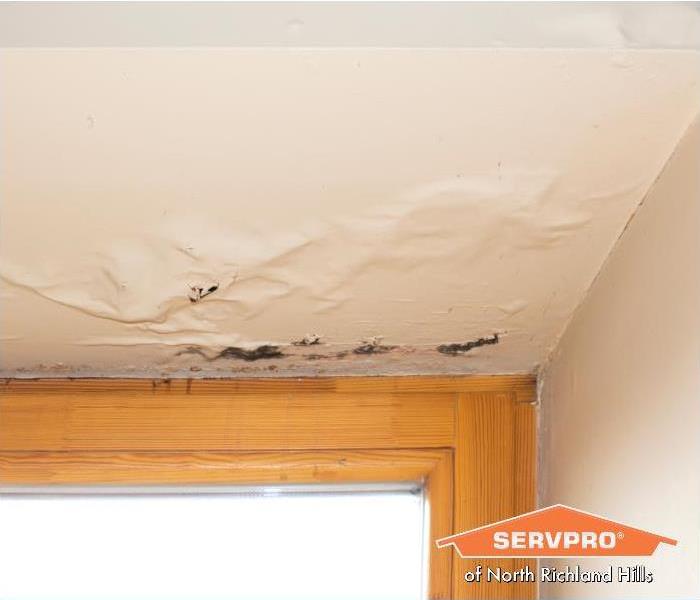 Contact the experts at our Fort Worth SERVPRO for professional water damage restoration services.
Contact the experts at our Fort Worth SERVPRO for professional water damage restoration services.
Possibly the most shocking thing about flooding is how fast it comes on with little to no warning. Suddenly, you’re grabbing up anything in the way that could be damaged: mail, books, family photos, electronics, etc.
At SERVPRO of Fort Worth, we know that water damage can happen at any given moment, so we are here around the clock to help property owners cope and recover. Weekends and holidays are no exception. We are always here.
SERVPRO’s 6-Step Water Damage Recovery Plan
Dependability begins with the consistent execution of a structured action plan. Our team of water damage specialists follow a thorough process and make adjustments as needed for your particular situation.
Our goal is to eliminate all traces of water and moisture to minimize the risk of secondary damage (such as rotting wood and toxic mold growth).
Step 1: Emergency Contact
Water damage specialists dispatch right away to stop the source of the flooding. We also take documentation photos and do a preliminary search to map out all the affected areas.
Step 2: Inspection and Damage Assessment
We dive deeper into the nature of the damage. We determine if the water present is toxic (like blackwater). We survey all the damage, assess moisture levels and spread, separate furniture from wet carpet, and do a complete safety inspection.
Step 3: Water Removal/Water Extraction
We deploy high-powered water extraction equipment to remove every gallon and ounce of water from your home or business. We work diligently to salvage carpet and furniture. Oversaturated carpet is replaced to prevent mold growth.
Step 4: Drying and Dehumidification
Moisture must be eliminated to prevent mold growth, so we create a drying plan tailored to your situation. We use advanced drying techniques along with the best moisture-detection and drying equipment available to ensure that your spaces are dry as can be.
Step 5: Cleaning and Repair
Just because the area is dry does not mean that it’s clean. We thoroughly clean and deodorize the entire contents of the affected are. We use professional-grade products and equipment as well as the Esporta Wash System to launder contaminated fabrics and soft goods.
Step 6: Restoration
What cannot be salvaged will be repaired with the same kind of work you would get from a contractor.
Contact SERVPRO of Fort Worth for 24-Hour Response
SERVPRO is equipped to handle 100% of your property’s restoration needs. Because our Fort Worth water damage restoration services are more comprehensive than most, we are the preferred restoration company by many insurance companies. We even work directly with your insurance company on your behalf.
When flooding happens, you need to act fast. The longer you wait, the worse it gets as mold begins to grow as soon as 48 hours after a flood event. Call us (817) 589-1499. We are available 24/7 for emergency contact.
What to Do After a Flood in Your Fort Worth House
2/11/2021 (Permalink)
What do you do when you have gallons of water trapped in your house? Perhaps your instinct is to grab a bucket and start scooping it all out, but that’s not necessarily the best thing to do first.
While severe weather floods the insides of homes and businesses in Fort Worth, the most common cause of internal flooding is plumbing failure. In this guide, we’ll share what to do after a flood step by step.
What To Do After A Flood in 7 Steps
Floods are stressful, and unfortunately, there aren’t any shortcuts in the recovery process. He’s what to do after a flood in seven steps.
- Be Safe - Here are safety tips to follow:
- Heed evacuation advisories.
- Seek alternative shelter if the structure is hazardous.
- Turn off the main power to the house even if there is a power outage. Note: For your safety, only do this if you can without walking through the water.
- Do not make contact with contaminated water without adequate personal protective equipment. Blackwater contains potentially life-threatening toxins.
- Call for Help - Sometimes the only way to manage a water emergency is to call for help. Here are some examples of who to call:
- 911 - You are in a dangerous situation, someone needs medical attention, someone is lost, etc.
- Emergency electrician - You cannot safely turn off the power.
- City - Water main break, sewage spill beyond your property line.
- Emergency plumber - Water is gushing, and you can’t turn it off.
- SERVPRO - Contaminated water has entered your home, and it’s unsafe to clean up.
- Insurance/warranty company - If you have coverage for water damage or water emergencies.
- Stop the Flooding - If the water source is internal (from plumbing, appliances, etc.), shut off the main water valve. When floodwaters are coming in from the outside (from a storm, city sewer, water main break), contact city services for assistance.
- Document - If it’s safe to approach and reenter the property, take plenty of photos, videos, and notes to pass along to the insurance company or home protection organization.
- Clean Up - Water must be extracted from the structure, and all contaminated objects must be carefully bagged up or disposed of.
- Prevent Mold - Mold begins to grow about 48 hours after a flooding event. The home or building must be completely dry to prevent mold from growing inside and outside the structure.
- Prevent Future Floods - Inspect the home for potential plumbing problems that need preventative repair. Consider installing a flood alarm in places that might flood without forewarning (for example, the basement).
Contact SERVPRO of Fort Worth for Flood Damage Restoration
SERVPRO has been a trusted provider of Fort Worth water damage restoration for decades. We remove gallons of water from structures with high-powered extractors and use advanced techniques to prevent mold growth.
If you have coverage, we are the preferred restoration company for many top insurance companies, plus we work directly with them on your behalf. Call us 24/7 for emergency contact at (817) 589-1499.
How to Fix a Toilet that Keeps Clogging Up
2/11/2021 (Permalink)
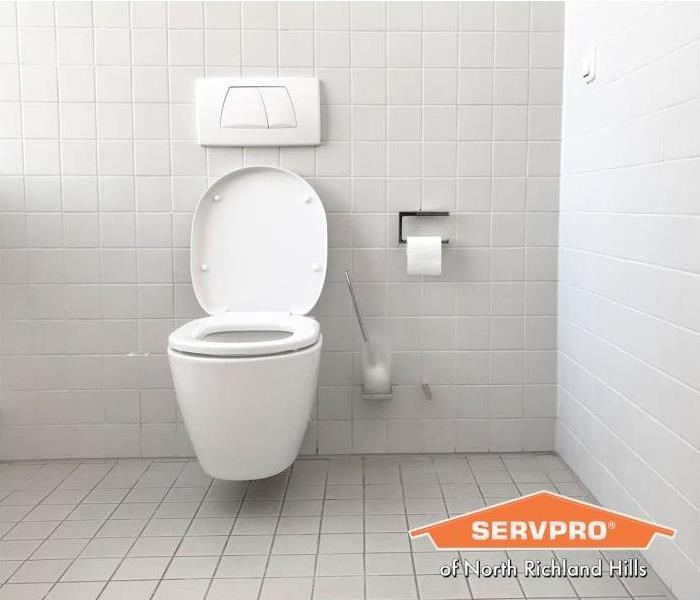 If a clogged toilet has made a mess in your house, contact the experts at SERVPRO in Fort Worth for professional water damage restoration services.
If a clogged toilet has made a mess in your house, contact the experts at SERVPRO in Fort Worth for professional water damage restoration services.
It seems that you use the plunger so often that you may as well leave it by the toilet.
So, why is the toilet getting backed up so often and how do you fix a toilet that keeps clogging up?
Reasons Why a Toilet Keeps Clogging Up
It could be the age of the toilet, plumbing issues, or user error. Below are the common causes of toilet backups.
- The toilet is old - First-generation low-flow toilets manufactured in the 1990s don’t flush materials as well.
- Materials - Not all toilets and not all plumbing can cope with “flushable” wipes, baby wipes, feminine hygiene products, paper towels, cotton balls, hair, or dental floss.
- Fill valve malfunction – The fill valve controls how much water collects in the tank, so there is enough water for the next flush. Without enough water to thoroughly flush the toilet, it becomes clogged.
- Blockage in the pipes - The toilet isn’t clogging, but a blockage in the pipe(s) causes a backup.
- Sewer line issues - The problem is not above ground with the toilet or plumbing, but below with a blockage in the sewer line.
- Plumbing vent damage – The plumbing vent is compromised, and this throws off the pressure needed for movement through the pipes.
Solutions for a Toilet that Keeps Clogging Up
Wondering how to fix a toilet that keeps clogging up? Here are things to try when your toilet backs up.
- Replace the toilet - If you have a low-flow toilet from the 1990s, upgrade to a newer one with an updated design.
- House rules - Make a habit of only flushing a reasonable amount of toilet paper. Everyone using the toilet should be made aware that flushing anything other than toilet paper could cause a backup.
- Check the fill valve - It could be that your toilet tank isn’t refilling properly. Open up the tank and check if there is enough water in the tank and check if the fill valve appears to be broken. Repair as needed.
- Call a professional - If you’ve tried everything to fix the toilet itself and there are still backups, there may be a problem with the plumbing or sewer line. These issues need to be diagnosed by a professional plumbing or sewer line service in Fort Worth.
Contact SERVPRO for Bathroom Water Damage Restoration
If toilet backups left a nasty mess, call SERVPRO for Fort Worth water damage restoration. Not only will we thoroughly clean up the wastewater, but we also use professional drying techniques to prevent mold growth.
In the case of a sewer backup, we get close to the contamination with personal protective equipment so that you don’t have to.
We can also help with many household repairs including plumbing. We’re here to take your call 24/7 at (817) 589-1499.
5 Steps to Take If Your Bathroom Floods
1/26/2021 (Permalink)
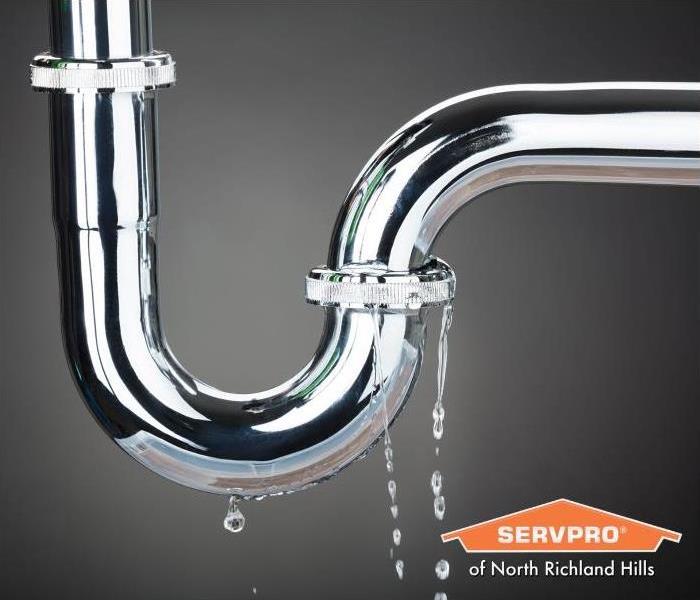 Flooded bathroom? Contact SERVPRO of North Richland Hills today for professional water damage restoration in the Fort Worth area.
Flooded bathroom? Contact SERVPRO of North Richland Hills today for professional water damage restoration in the Fort Worth area.
Toilets, sinks, bathtubs, and showers all offer opportunities for a bathroom to flood. We use the bathroom so often that we take for granted that water will shut off and drain properly.
Until one day we are met with a scene that looks more like a waterpark than a bathroom. Some may think that bathroom floods are a bigger problem than they can handle. However, even if you plan to call for someone skilled to help, there are still things you should do on your own to manage the situation. For starters, you should stop the water flow by locating and shutting off the water valve.
SERVPRO of Fort Worth is all about being prepared to take action in a water emergency. We put together this quick and easy guide to address bathroom floods.
Common Causes of Bathroom Flooding
Perhaps you have an old house where the plumbing is starting to fall apart. Even those who live in newer properties may run into some bathroom flooding events. How many types of bathroom floods have you encountered?
- Tub or sink flooding when there is a clog that prevents draining.
- Toilet floods are flushed several times with a stubborn blockage.
- Burst pipes from freezing cold weather or old plumbing.
- Faucet left on.
No matter the reason for a flooded bathroom, you’ll need to find the cause quickly so you can stop it from getting worse.
How to Stop Bathroom Flooding
Water all over the place can cause a bit of panic. What do you do first when a bathroom floods? Grab a mop and bucket?
Below are the steps you should take in the order you should do them. It begins with stopping the water at its source.
1. Shut off the Water Valves
The first thing you should do is to shut off the water. This could be the faucet, the external valve of the toilet, a valve under the sink, or the main water supply into the house (in the case of a burst pipe situation.
Plan to leave the water off until the source of the flooding is resolved. If you turn it back on too soon, there will be more flooding which leads to increased potential for damage.
If it’s the toilet that is overflowing, avoid flushing it until the issue is resolved. Flushing when there is a clog is one of the main causes for a toilet to overflow. Use a plunger to release the clog. Once the toilet bowl drains, you can try flushing the toilet again to check if the blockage has been successfully removed.
2. Remove Standing Water
Clearing out bathroom floods is a big job, but the sooner you remove the water the better. Standing water can be damaging, unhygienic, and creates a safety issue if it makes contact with electricity.
Using a bucket or other container, scoop out the water and empty where it can drain (kitchen sink, tub in another bathroom, dump it outdoors, etc.)
Once most of the water has been removed, use an absorbent mop or a thirsty towel to soak up as much water as possible. Have a bucket nearby to wring out saturated mops and rags.
Use a wet/dry shop vac to assist you with water removal (if available) but be careful not to let cords make contact with water puddles.
3. Open Windows and Bring in Fans
Even the most aggressive water removal tactics aren’t enough to get rid of all water. It’s likely there will still be some streaks and dampness lingering here and there.
The way to move all moisture out of the bathroom to make it completely dry is to use the force of air. The air will evaporate and leave the space via airflow.
Using high-powered fans you can dry out the area effectively. This works even better when you have a window to open in the bathroom. Again, be careful not to let electrical components make contact with water puddles.
The idea is to promote as much airflow as possible so that remaining dampness and moisture will be eliminated. Lingering water and moisture lead to mold growth and potential wood rot (cabinets, baseboards, subfloor, etc).
4. Find and Fix the Source of the Problem
You’ve worked so hard to get your bathroom dry again. Now it’s time to be proactive so that it doesn’t happen again.
This involves preventing clogs in plumbing, repairing plumbing, or coaching members of your household to not leave the water running. If there is a recurring problem of someone (like a child) leaving the water on, you might consider installing sink faucets that are designed to shut off after a few minutes or install water level alarms.
If after examination of the bathroom, you still can’t find the cause of the damage or if the source is in a place you can’t easily access, your best bet is to contact a professional.
A plumber may be the first thing that comes to your mind, but SERVPRO in Fort Worth, TX is also skilled at locating and addressing the source of water damage problems.
5. Document the Damage
If you believe the damage is substantial enough to warrant an insurance or home warranty claim, you’ll want to take photos and video as proof of the damage. It’s important not to procrastinate here because the conditions will change over time. You should capture evidence at the onset of the damage.
How Long Does it Take for Water Damage to Show?
Signs of water damage will appear as soon as 24 hours after the water has been extracted. Some damage may not show up for a few weeks.
- Discoloration (stains on drywall, ceilings, etc.)
- Change of texture on surfaces or materials
- Wood warping, buckling, sagging, sinking, swelling (usually from toilet or bathtub flooding).
- Appearance or smell of mold or mildew.
The potential for mold growth is a chief reason to address water damage right away. Mold spores begin to colonize as soon as 48 hours after a bathroom floods. Some species of mold are toxic and damaging. However, it may take several more days before you see or smell the mold.
How to Prevent Bathroom Flooding
The more your bathroom floods, the greater the potential there is for water damage and mold growth. To avoid the constant hassle of wet messes, here are some tips to prevent bathroom flooding
- Drain guard - To avoid clogs, catch hair and other potential clogs with a strainer that properly fits the drains of your bath, shower, or sink drains.
- Watch what you flush - Wipes and some hygiene products are said to be okay to flush, but not all plumbing systems allow these to pass through. Also, keep an eye on small children who may try to flush toys and other objects down the toilet. Keep bathtub toys out of reach when not in use.
- Plumbing repairs - If your plumbing shows various signs of failure, or if you know that these are aging, it’s time to invest in repairs. The older a house is, the more likely it is that pipes, faucets, or toilets need to be replaced. Fixing these before they become a problem can save you the headache of a flooded bathroom.
- Install prevention mechanisms - This could be a drain in the floor of the bathroom or a flood stop device.
- Keep it dry - For areas that frequently collect water, use absorbent mats, a mop, and an exhaust fan to clear the bathroom of moisture after taking a bath or shower.
- Communicate - Ask household members to remember to turn off the water after use, and keep things out of drains and toilets that could cause a flood. Explain to them that bathroom floods cause water and mold damage. Children may need supervision in the bathroom as they learn how to use the sink, toilet, bathtub, etc. appropriately.
Contact SERVPRO for Fort Worth Water and Flood Damage Repair
Bathroom floods are infrequent, but you can be proactive to either keep these from happening in the first place or take action right away when it does.
SERVPRO of North Richland Hills is always ready to take action on any flooding situation, big or small. Not only do we Fort Worth water damage restoration for both commercial and residential properties, but we can also handle common household repairs. We work directly with your insurance company should you need to file a claim.
Should you walk into a messy bathroom flooding situation, we’re here to help. Call us at (817) 589-1499 for emergency contact 24 hours a day, 365 days a year.
How to Find a Water Leak
10/27/2020 (Permalink)
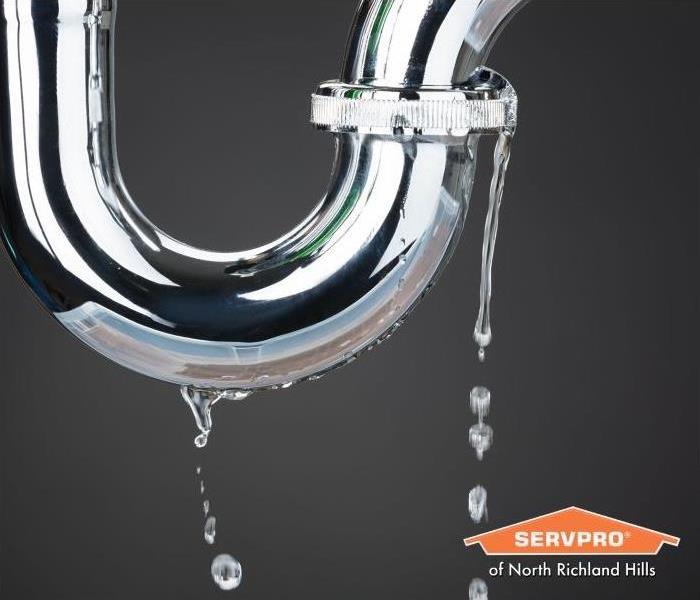 Think you have a water leak in your home? Contact SERVPRO in Fort Worth for professional water damage restoration services.
Think you have a water leak in your home? Contact SERVPRO in Fort Worth for professional water damage restoration services.
The EPA estimates that 3,000 gallons per year can go to waste from a leak at the rate of one drip per second. Aside from wasting a precious resource, water leaks also impact your budget. Whether you put the water to good use or not, you’ll be charged by the meter’s gallon count.
Another way water leaks will cost you is with water damage accumulation. Fort Worth property owners may not notice faulty plumbing or malfunctioning appliances in tucked-away places (like a water heater) until nearby items and construction have already been ruined.
If the amount due on your water bill is surprisingly high and your utility company can’t explain why then it’s time to look around your property for answers. Today, we’ll walk you through how to find a water leak.
How to Find a Water Leak in Your Home
Some water leaks in the house are obvious (like drips under the sink or behind the toilet. If you discover a problem and fix it, does it stop there? Perhaps not. There could be other leaks that are still wasting water.
Why not take the time to do a full inspection of your property to make sure there are no other problems? A thorough search for water leaks could save you in the long run - both with utilities and damage repair costs.
Examine Fixtures and Appliances
How to find a water leak in your house begins inside with a high-level inspection. This includes checking all the fixtures and appliances that the plumbing routes to.
- Toilets: Look over the toilet’s tank parts for wear or weaknesses (especially the flapper valve).
- Bathtubs and showers: Check bathtubs and showers for drips or puddles around the bases of toilets, tubs, and separate showers.
- Sinks and cabinets: Look under kitchen and bathroom sinks for signs and smells of water. Check each cabinet near a water usage area to make sure everything is dry.
- Clothes washer and dishwasher: Run the washer to check for malfunctions. Pull out the appliances to check the connection hoses for leaks. Also, check for puddles around the washer.
- Water heater: Examine water heater for connection hose leaks or water collecting below. Since water heaters are usually out of sight and out of mind, you might consider fitting it with a moisture sensor alarm, so you’ll immediately know if it springs a leak.
If you come across any puddles, shut off the water supply to the associated appliance or fixture and contact a plumber for further assistance.
Observe Your Water Meter
How to detect water leaks begins with water meter leaks confirmation.This is a surefire way to know if you have an unresolved water leak with your property.
A water meter is usually found near the road where the utility company can access it without intruding on your property. Look for a covered box or a covered manhole.
If you have trouble locating the water meter, contact your utility company to ask where it is. Once you find the meter, follow the four steps below.
- Stop all running water by turning off all water faucets, the washing machine, or the dishwasher. They will need to remain off for the duration of the test. Ask members of the household to cooperate with this by not using any sinks, tubs, showers, toilets, or water-using appliances until the test is complete.
- Go to the water meter and copy down the number on the counter.
- After some time has passed, check to see if the numbers have changed:
- If after a few minutes, you see the number has increased, there is likely a fast-moving leak.
- Check again in an hour or two. If the number goes up, then there is likely a slow leak. If the number still hasn’t changed after two hours, then it’s not likely that there are any leaks.
- Once you detect a leak by meter confirmation, you can rule out if the leak is happening with outdoor functions. You’ll do this by shutting off the house’s main water supply.
Keep all water turned off as mentioned in the above steps, but then shut off the water supply to the house itself. This control may be in your basement or utility room. Write down the meter’s counter number. Check again after an hour to see if the number on the counter has changed. If it hasn’t, the leak is inside the home.
Monitor Your Water Bill
How much water use is considered excessive? For a household with four members, a bill that reflects a usage total of more than 12,000 gallons in a given month is too much. A spike like this could mean that there is a leak somewhere.
You can track changes in usage by comparing billing statements over several months. If you see that there is an abrupt change in the amount due (or in the total gallon count), you’re likely being charged for water you haven’t really used.
Unless someone is somehow stealing water from you, this change can probably be blamed on water leak problem(s). The water leak issues could be complex or underground.
Be Aware Of Leaking Clues
Once you’ve checked the areas where leaks commonly occur, you’re ready to go a bit deeper in your search for any peripheral issues.
Water leaks can be inaudible or invisible when behind walls or ceilings. If these leaks go on for some time, they eventually make themselves known by showing signs of damage. Here’s what to look for:
- Wall or ceiling discoloration: Water stains signal that a water leak from pipes or a faulty roof has been going on long enough that the wall and ceiling material is now becoming saturated with water. These marks are typically a yellowish or brownish color.
- Dripping sounds: It can be hard to hear dripping water behind a wall or ceiling, so if you do hear dripping sounds, this signals that the problem may have progressed into an urgent matter.
- Deformed walls: Walls and ceilings should be flat and smooth. Any bubbling, bulging, swelling, or warping of paint, drywall, or wallpaper is a sign that water has accumulated so much that it is soaking through the materials.
- Seeing or smelling mold: Mold can be discovered by its musty odor or dark and speckled spots. This means that water damage has been sitting long enough for mold spores to take root and colonize.
Water ends up where it doesn’t belong by way of failures with plumbing, appliances, fixtures, or structure (such as the roof or windows). Awareness of how water leaks make themselves known can help you spot trouble right away.
Food Coloring in Your Toilet
How to find where a leak is coming from can be done with a clever color test. This lets you know if your toilet is faulty.
Put a few drops of dye or food coloring in the toilet tank. Do not flush the toilet. Wait for 10-20 minutes. If you see the water in the toilet bowl is tinted with the color you used, this indicates a leak.
This kind of toilet leak happens when the flapper (rubber stopper) in the toilet tank wears down over time. A weakened flapper allows water to bypass the seal. To solve this water wasting issue, replace the flapper with a new one (appropriate for your commode).
Water Leak Outside Your Home
Once you’ve ticked all the boxes for indoor inspection, you can check the rest of your property. Take recent weather into account. If it has recently rained, then it’s uncertain if the puddles or saturated ground is due to a water leak.
Even when finding a water leak outdoors was ruled out by the meter test, you can still check the external water functions for signs of wear (that may lead to future problems). Here’s how to find a water leak outside.
Inspect Your Shut Off Valve
The outdoor shut-off valve is usually located around the water meter. Look for nearby puddles or signs of water saturation around the shut-off valve and any exposed supply lines.
Greener Patches of Grass
How to find a water leak underground can be as simple as looking out over the lawn. Are there patches of grass that are a brighter green than the rest? This could be a sign that some parts are getting more water than others because of a water leak.
One possible cause is a fault with the irrigation system. If the leak is severe, puddles may form on the surface near the watering system.
Don’t forget to check outdoor spigots, hoses, gaskets, and connection pieces for breakage or aging. Turn on the water to check for weaknesses. Apply the appropriate repair methods to these problems or contact a plumber.
Becoming aware of what seems to be wearing down now helps anticipate future water problems.
Contact the SERVPRO Professionals of Fort Worth Water Damage Restoration
Being on the lookout for signs of water leaks could mean saving lots of money in repairs and utility bills. Those who own properties that are older than 20 years should especially be observant of breakdowns from years of wear and tear. It’s a good idea to schedule routine inspections and maintenance for your home.
SERVPRO of North Richland Hills has successfully resolved water leak issues and repaired water damage for countless properties in Fort Worth, Texas. We have the expertise on how to find a water leak and quickly stop the problem at its source.
Our water damage restoration Fort Worth services response team is trained on the latest industry advancements, and we send them out with the best equipment in the industry.
Don’t let a water leak issue get out of control. We’re here to help you solve the root causes of water leaks and do the necessary fixes to prevent secondary damage (like wood rot or mold growth). Call us at (817) 589-1499 today!
Water Damage Restoration in Fort Worth, TX
6/16/2020 (Permalink)
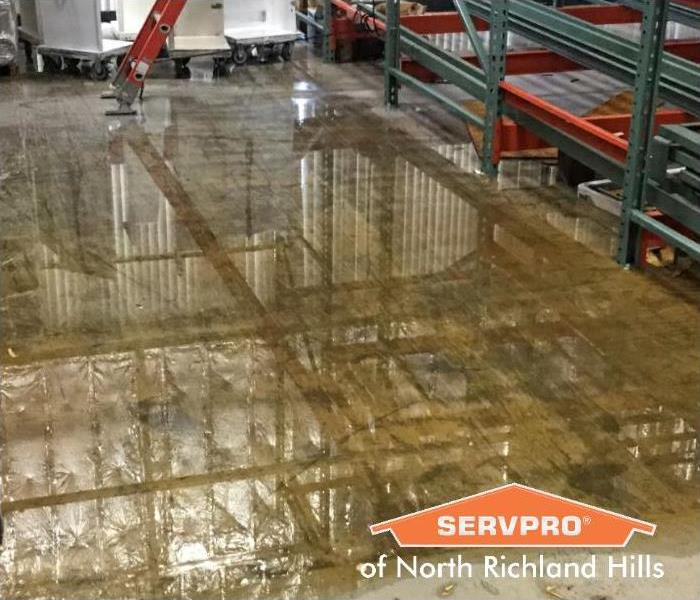 Water Damage Restoration in Fort Worth
Water Damage Restoration in Fort Worth
Every year we see dramatic weather changes in Fort Worth. From freezing rain to severe summer thunderstorms, the weather brings water with it. Seasons have the potential to impact homes with burst pipes in the winter or flood damage in the summer.
Your water emergency is our emergency - natural disasters and otherwise. SERVPRO of North Richland Hills is here to assist you with water damage events around the clock.
For 24/7 Water Damage Restoration in Fort Worth and North Richland Hills
SERVPRO of North Richland Hills is a locally owned and operated home and commercial restoration company. Over the last 30 years, we’ve dealt with every kind of water damage scenario. We are the experts on water damage restoration and mold removal in Fort Worth!
Who we are:
- 24-hour emergency service, 7 days a week
- We live by our motto: “Faster to Any Size Disaster.”
- A staff of highly trained Water Restoration Technicians.
- A trusted leader in the Water Restoration Industry.
- Provider of advanced water inspection, extraction, and drying equipment.
You can count on us to provide timely and thorough water removal and flood damage cleanup services at the time you need it most.
What Causes Water Damage in Fort Worth?
Water emergencies come in all kinds from torrential downpours to plumbing failures. However the water gets in, it’s likely to cause damage and problems. While basement flooding is common in some parts of the country, it isn’t in our area.
Here are some potential scenarios Fort Worth and North Richland Hills residents may experience.
- Flooding or storm damage from severe weather.
- Flooding from firefighting operations.
- Overflowing gutters.
- Water seepage into attics and crawl spaces.
- A sewage backup into the home or business.
- Pipes burst or leak.
- Plumbing system issues.
- Overflow from toilets, bathtubs, and sinks.
- HVAC system problems.
- Leaking from appliances, water heaters, plumbing, etc.
Water mitigation remedies can be made to prevent the above issues from happening. But when these situations happen regardless, timely water damage restoration may be necessary.
The cornerstone of our business is professional water damage services. For this purpose, we have our technicians on-call and ready to dispatch to the property when you need us.
Upon arrival at the scene, we are fully prepared and equipped to get started on the water damage restoration process immediately. We are the leader in the restoration industry because we are reliable and consistent.
What Are Signs of Water Damage?
Too much water exposure leaves signs of water damage. The sooner you discover them, the quicker you can act to prevent mold problems with proactive cleaning and remediation.
- Trapped water - Water accumulates in pools or puddles or accumulates by several inches of water with flooding.
- Discoloration or spotting - Conspicuous discolored or dark areas on floors, ceilings, or walls. These might also appear around pipes, sinks, toilets, etc. Also, check inside cabinets and closets. Peeling or cracking paint or drywall may also be a sign that water damage occurred.
- The floor feels squishy or squeaks as you walk.
- The sounds of rushing water when no outlets are turned on.
- Mold can be seen.
- The presence of mildew - The room smells or feels musty. Mildew may also be accompanied by humidity.
- Sewage smell.
- A spike in the utility bill.
If you observe any of the above, take action. Being proactive prevents things from getting worse and allows you to restore the space back to its original state.
Our Water Damage Restoration Process
SERVPRO of North Richland Hills’ thorough water damage restoration process is the best in the Fort Worth area. We understand that no two situations are alike, so we approach our inspections with this goal in mind - to determine the best restoration and cleaning solutions for your particular circumstances.
What we do:
- Water removal: We extract all standing water from the affected areas. This includes sewage cleanup.
- Water clean up: We clean everything that comes into contact with water. We make sure the property is thoroughly cleaned and dried to prevent mold growth. When necessary, this process includes disinfection and complete carpet cleaning.
- Mold inspection: Our top priority is preventing a mold health hazard. We carefully inspect for mold as part of our cleaning process. Several of our staff are Texas certified mold technicians trained for thorough mold remediation during the restoration process.
- Water damage repairs: What cannot be salvaged during our cleaning process will be replaced or rebuilt.
Our expert cleaning and restoration procedure consists of these 6 steps:
Step 1: Emergency Contact
Step 2: Inspection and Damage Assessment
Step 3: Water Removal/Water Extraction
Step 4: Drying and Dehumidification
Step 5: Cleaning and Repair
Step 6: Restoration
Our cleaning process is customized according to the extent of the damage and the contamination levels we find on-site. Each step will be planned according to the particular restoration needs for your property damage.
This thorough process prevents the growth of mold, bacteria, and other toxic microorganisms that have the potential to cause further damage and create potential health risks.
Contact SERVPRO NRH Today for Water Damage Restoration in the Fort Worth Area
SERVPRO of North Richland Hills has this goal in mind - make it "Like it never even happened."
Our IICRC certified technicians are equipped with the experience, knowledge, and the training needed to deliver a complete restoration and cleaning that is well worth the investment.
Our company has served the Fort Worth area for more than 40 years providing residential and commercial cleaning services. We’re ready to act at the time of your call.
Don’t wait for the water damage to get worse or become a mold health hazard. Call the experts anytime at (817) 589-1499. You may also submit your inquiry by using our quick and easy contact form anytime.
Catch Appliance Leaks Before Water Damage Occurs
2/12/2020 (Permalink)
 All household appliances that utilize water are prone to leaks in one way or another, but if these leaks are not caught early, water damage can begin.
All household appliances that utilize water are prone to leaks in one way or another, but if these leaks are not caught early, water damage can begin.
All household appliances that utilize water are prone to leaks in one way or another, but if these leaks are not caught early on, water damage can begin.
Because many appliances are not moved or inspected with frequency, this water damage can be harbored for ages before homeowners are made aware—this is why regular inspections are so important for prevention.
Inspect These Appliances for Leaks Often
Hot Water Heater
The lifetime of a hot water heater will typically span 10 to 15 years, but leaks can start much earlier than this. The seals and pipes connected to the hot water heater can often break down, so keeping an eye out for any accumulation both during and after use is a smart move.
Refrigerator
The rarity with which refrigerators are moved can lead to secret water damage that festers for ages before it is brought to light. A refrigerator’s water lines are typically made from a soft plastic that can easily fail, so checking for leaks behind and under the fridge as part of your annual home maintenance is wise.
Dishwasher
A dishwasher’s tubing is just as problematic as a refrigerator, but is even more isolated and utilizes far more water. Additionally, homeowner’s insurance often does not cover water damage caused by older models of dishwashers, so regular checks are extremely important to keep up with.
Washing Machine
Washing machine hoses are some of the most common sources of leaks. Because they are notorious for this, it is recommended that they are inspected at least once a month by homeowners so you can be sure no issues have arisen. In addition to these regular checks, they should be fully replaced every five years in order to prevent hidden deterioration.
Air Conditioner
The drain in your HVAC unit is designed to keep condensation from pooling in and around the unit, but if this drain malfunctions, water damage can quickly be caused. Reference your manufacturer’s manual to determine how often your unit should be inspected and serviced—having a professional technician evaluate your machine is the best defense against HVAC-created water damage.
If your home or business is affected by an appliance leak, call SERVPRO of North Richland Hills! Our teams handle Fort Worth water damage restoration and are here to help.
Saving your Hard Wood Floors Following Water Damage
1/31/2020 (Permalink)
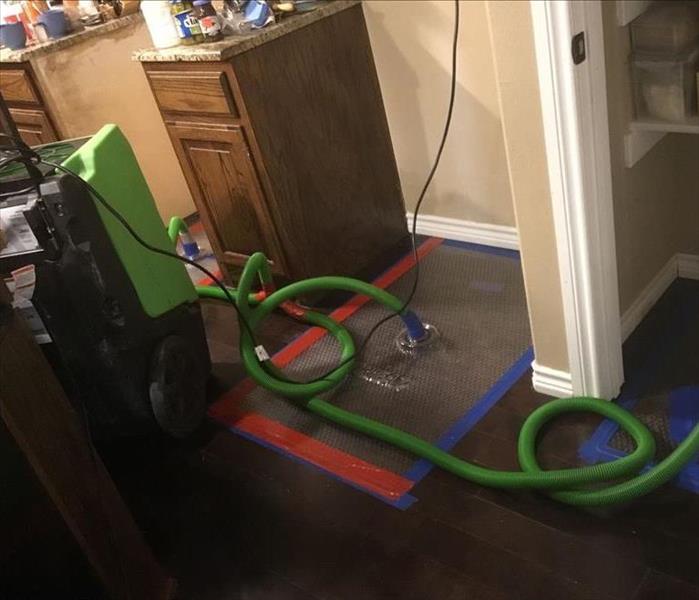 SERVPRO mat system used to save wood floors.
SERVPRO mat system used to save wood floors.
A flooding event of any size will have a negative effect on your building and property, and your wood floors will really suffer. Any time water saturates hardwood, the wood absorbs the water through its pores and this, in turn, causes warping and discoloration. If you have experienced water damage to your wood flooring, you will want to follow these steps to repair them:
- Removing Water. Soak up the water as quickly as possible. The longer the water remains, the worse the damage will be. The first 24 hours are critical, but if you are able to remove the water and dry your floors completely, you may be able to avoid serious and irreversible damage. You will also be alleviating the possibility of a mold invasion.
- Sanding/Refinishing. You will need to sand and refinish the wood. This repair can bring your floors back to pre-flood condition and will save you all the time and money involved in having your damaged flooring removed and new flooring installed.
- Contacting Professionals. When you have experienced extensive water damage, such as from a tornado, hurricane, or severe flooding due to a large weather event, your best bet will be to contact a professional water damage restoration service. They are experts in this area and will have the personnel and equipment necessary to get your water damage taken care of as fast as possible. Make sure you call them right away! If your area has suffered a weather disaster, these companies will probably have a waitlist.
- Taking Preventive Measures.
SERVPRO of North Richland Hills has the skills and equipment necessary to get your floors back to pre-damage condition, and we are always here to help with repairs and renovations to any area of your property when you are affected by water damage event, whether large or small. We also handle fire damage, and we are mold remediation experts, too.
Understanding Water Types
1/10/2020 (Permalink)
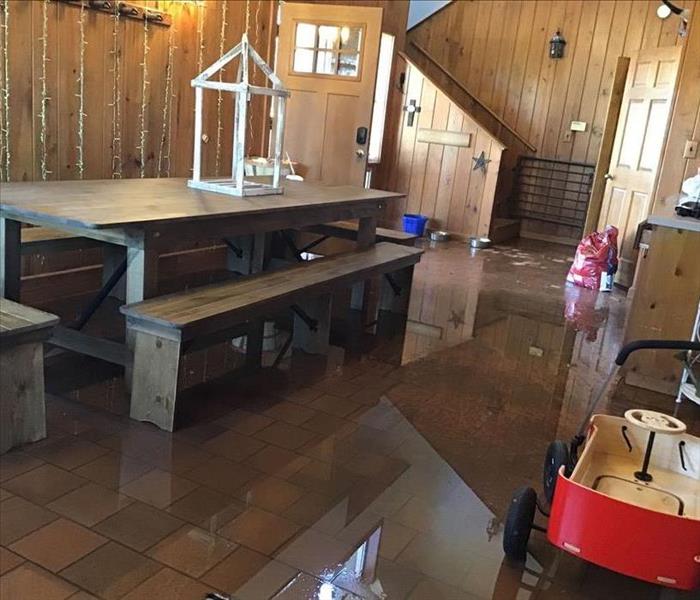 When your home or business suffers a water damage, understanding what type of water you are dealing with is critical to ensuring proper cleanup.
When your home or business suffers a water damage, understanding what type of water you are dealing with is critical to ensuring proper cleanup.
When your home or business suffers a water damage, understanding what type of water you are dealing with is critical to ensuring proper cleanup.
There are three types of water. Clean water (Category 1 water) is water from a broken pipe, or other water source; rainwater is also considered clean. The term gray water is used to classify slightly contaminated water (Category 2 water). Clean water becomes gray water when it is left untreated allowing bacteria and other contaminants to begin growing, making the water hazardous. Black water (Category 3 water) is highly contaminated and filled with fungi, bacteria, chemicals and more. Black water is typically caused by sewage damage, flooding, or any type of natural disaster. Black water should always be handled by trained professionals.
Consider taking the following precautions to help minimize damage or prevent further damage while waiting for SERVPRO of North Richland Hills to arrive:
Damage from Clean Water
- Shut off the water source if possible or contact a qualified professional to do so.
- Turn off circuit breakers for wet areas of the building if access to the power distribution panel is safe from potential electrical shock. Do not enter rooms with standing water, as electrical shock hazards may exist.
- Remove as much excess water as possible by mopping and blotting. Wipe excess water from wood furniture after removing lamps and tabletop items.
- Remove and prop up wet upholstery cushions to allow more even drying.
- Move any paintings, art objects, computers, documents and other valuable items that may be sensitive to moisture, to a safe place.
- Do not leave books, newspapers, or magazines or other colored items on wet carpets or floors as they may cause staining.
- Do not use your household vacuum cleaner to remove water as there is potential for electrical shock or causing damage to the vacuum cleaner.
- Do not turn on ceiling fixtures if the ceiling is wet; do not enter rooms where ceilings are sagging from retained water.
Damage from Contaminated Water
- Avoid all contact with sewage and items contaminated by sewage. Wash your hands thoroughly if you come in contact with contaminated items.
- Do not walk through contaminated areas, as you could spread damage to unaffected areas.
- Do not turn on the HVAC system if there is a possibility of spreading contaminated air.
- Do not use household fans to dry the structure; air flow could spread contaminants.
- Discard any food and/or products for personal hygiene and cleanliness if exposed to the contaminated areas.
Are you Winter Weather Ready?
12/9/2019 (Permalink)
 Frozen Pipes
Frozen Pipes
Are you prepared for the upcoming cold weather? Cold weather can have a huge impact on your home or business if you are not ready for it. From rain and freezing temperatures to damaging winds, sleet, or snow, all can cause serious and costly property damage. While you cannot control the weather, you can take steps to be prepared and help take the sting out of winter weather. To help prevent costly damages due to weather, consider taking the following precautions to protect your property before the cold weather hits.
- Check your business property for downed tree limbs and branches. Wind, heavy rain, ice, and snow can cause branches to fall, which could cause damage to the property and potentially cause personal injuries.
- Roofs, water pipes, and gutters should all be inspected to help ensure they are in the proper order. Gutter downspouts should be directed away from your building. Clear gutters of debris that may have gathered during the fall. Leaves and other obstructions can cause a damming effect, which can lead to roof damage and interior wall problems.
- Inspect property, especially walkways and parking lots, for proper drainage to alleviate a potential flood hazard.
- Inspect all handrails, stairwells, and entryways to address and correct potential slippery of hazardous areas. Install mats or non-slip surfaces and post caution signs where water could be present.
- Protect water pipes from freezing by simply allowing water to drip when temperatures dip below freezing. If pipes are under a cabinet, leave the cabinet doors open, allowing warm inside air to circulate around the pipes. If the building has outdoor faucets, consider shutting water off at the main valve in the basement or crawl space. Once the valve is off, open the outdoor faucet to ensure it drains, preventing any remaining water from freezing in the pipe.
- Ask any of the professional at SERVPRO of North Richland Hills about completing an Emergency READY Profile (ERP) for your business. The ERP is a no-cost assessment of your facility and provides you with a plan to get back in business faster following a disaster. Preparation is key to making it through any disaster, whether it is a small water leak, a large fire, or an area flood. The best time to plan for such events is not when the event happens, but well beforehand. No one ever plans on disaster, but now, you can plan and prepare for it.
When winter weather strikes, call SERVPRO of North Richland Hills to strike back and help make it "Like it never even happened."
Water Damage Timeline
11/18/2019 (Permalink)
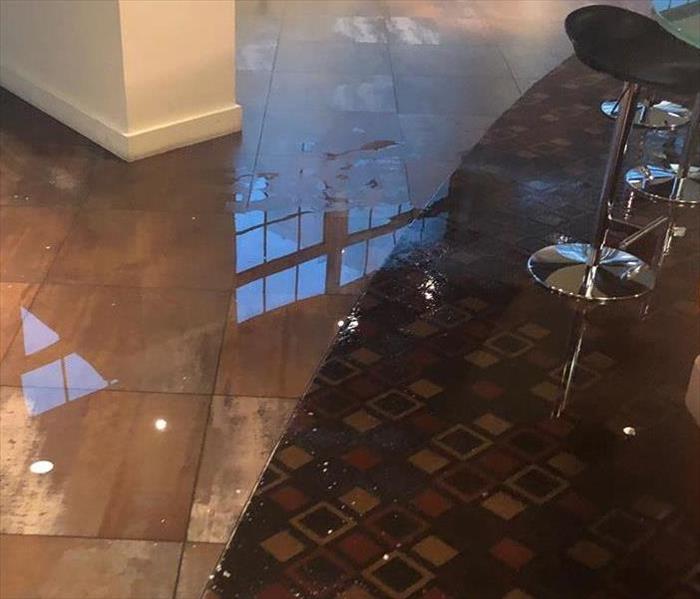 Local business affected with water damage.
Call SERVPRO of North Richland Hills If your home or office sustains water damage
Local business affected with water damage.
Call SERVPRO of North Richland Hills If your home or office sustains water damage
Water Damage Timeline
Here at SERVPRO of North Richland Hills, we know a fast reaction is a key part of preventing water damage, but what happens if you don’t take care of the water right away? Check out the timeline below to see what happens when water damage is left unchecked.
Within Minutes:
- Water spreads throughout the property and saturates all surfaces it comes into contact with. It is absorbed into carpets, walls, etc.
- Furniture finishes may bleed, or other dyes may begin to run and stain other surfaces.
- Photographs, books, and other paper goods begin to warp.
1-2 Hours:
- Drywall begins to warp and break down.
- Metal begins to tarnish & other furniture begins to warp and crack.
- Musty odor appears.
48 Hours – 1 Week:
- Mold may begin to grow.
- Doors, windows, and studs swell and warp.
- Metal begins to rust and corrode.
- Biohazard Contamination is possible.
More Than 1 Week:
- Restoration time and cost increase dramatically.
- Serious health risk posed to building’s inhabitants.
If your home or office sustains water damage, don't hesitate! Call us right away at 817-634-5509
The Clock is Ticking....
11/14/2019 (Permalink)
 The clock is ticking with water damage!
Call SERVPRO of North Richland Hills (817)634-5509
The clock is ticking with water damage!
Call SERVPRO of North Richland Hills (817)634-5509
A busted pipe, toilet overflow and a hot water leak are just a few examples of water damage that can happen in your home or business.
When this happens, you must act fast!
Did you know, it only takes 24-48 hours before mold starts to form? This means, you have to act fast to get the water removed from your home!
- If you know the location of the water source and it can be turned off, do this first!
- Call your insurance to submit a claim
- Call SERVPRO of North Richland Hills for your water damage needs at 817)634-5509
Because SERVPRO of North Richland Hills works 24 hours a day, 365 days a year; we can make sure we get to you before it's too late and becomes a bigger problem. Acting fast can save you time and money!
Water Problem?
11/14/2019 (Permalink)
 You can trust SERVPRO ofNorth Richland Hills. We will help to make things right, make things dry, and make it “Like it never even happened"
You can trust SERVPRO ofNorth Richland Hills. We will help to make things right, make things dry, and make it “Like it never even happened"
Let SERVPRO of North Richland Hills be the solution!
A pipe bursts. A water heater leaks. A bathtub overflows. Flood waters rush in. A sprinkler system malfunctions. Water damage can happen in any number of ways. But, if your business or home is under a few inches of water, everything else takes a backseat. Only one thing matters when your business can’t operate, and there is just one thing on the mind of the water-logged resident: A solution.
Your local SERVPRO of North Richland Hills Professionals are that solution. Equipped with the knowledge, the experience, and the training to help make your water damage “Like it never even happened.” SERVPRO Professionals will start helping the moment you call. Backed by more than 40 years of experience, your SERVPRO Professionals will help put your worries at ease, because they understand the sciences of drying.
When water damage strikes, give SERVPRO of North Richland Hills a call at (817) 634-5509
We will help to make things right, make things dry, and make it “Like it never even happened.”
The Do's and Don'ts of Emergency Water Damage
11/12/2019 (Permalink)
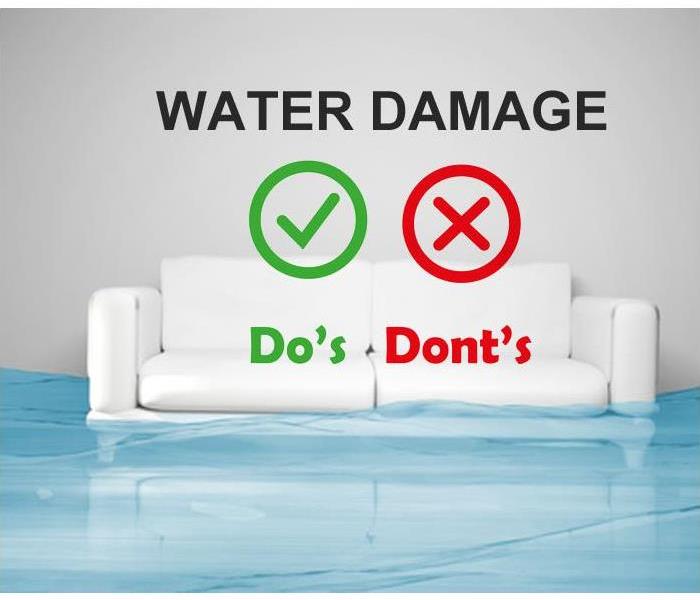 In the event of water damage please call SERVPRO of North Richland Hills. We are always here to help 24/7!
In the event of water damage please call SERVPRO of North Richland Hills. We are always here to help 24/7!
These emergency tips will assist you in taking the proper actions until SERVPRO of North Richland Hills arrives! Following these tips will help reduce damage and increase the chances of a successful restoration.
The Do’s and Don’ts
DO: Contact SERVPRO of North Richland Hills. We are open 24/7 for all of your water damage restoration needs.
DO: Eliminate the source of water if possible
DO: Remove as much excess water as possible by mopping and blotting.
DO: Relocate any valuables that could be damaged by humidity or water – photos, jewelry, artwork, etc.
DON'T: Enter rooms with standing water where electrical shock hazard may occur.
DON'T: Enter affected areas if electrical outlets, switches, circuit breakers or electrical equipment are exposed to water. Always avoid electrical shock hazards.
DON’T: try to suck up water with your vacuum, even if it is a wet/dry vac.
DON'T: Leave books, newspapers, magazines or other colored items on wet carpets or floors as this may cause staining.
In the event of water damage please call SERVPRO of North Richland Hills at (817)589-1499.
We are here to help 24/7!
Freezing Pipes
11/11/2019 (Permalink)
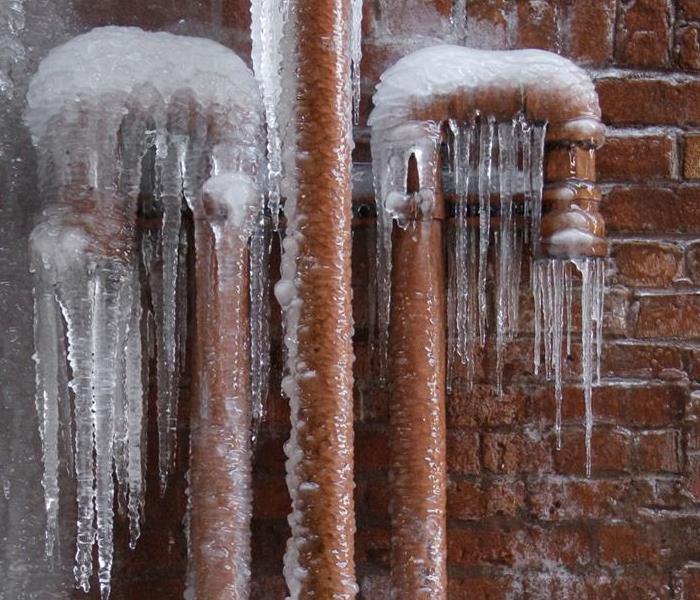 Prevent freezing pipes
Prevent freezing pipes
Brrr! The winter months are moving in full force and it’s time to prepare your home for freezing (and in some cases, below-freezing) weather conditions.
Freezing temperatures can cause water pipes to freeze. Freezing in a pipe creates a lot of pressure inside the pipe and can cause the pipe to burst and likely lead to serious flooding, especially when there's no one around to turn off the water. The best prevention against frozen pipes is to keep them warm enough to stay above the freezing point.
Running water through the pipe - even at a trickle - helps prevent pipes from freezing. Keep the thermostat set to the same temperature both during the day and at night.
Call SERVPRO of North Richland Hills if you experience water damage from pipes bursting at (817) 589-1499
All Your Flood Insurance Questions Answered!
3/8/2019 (Permalink)
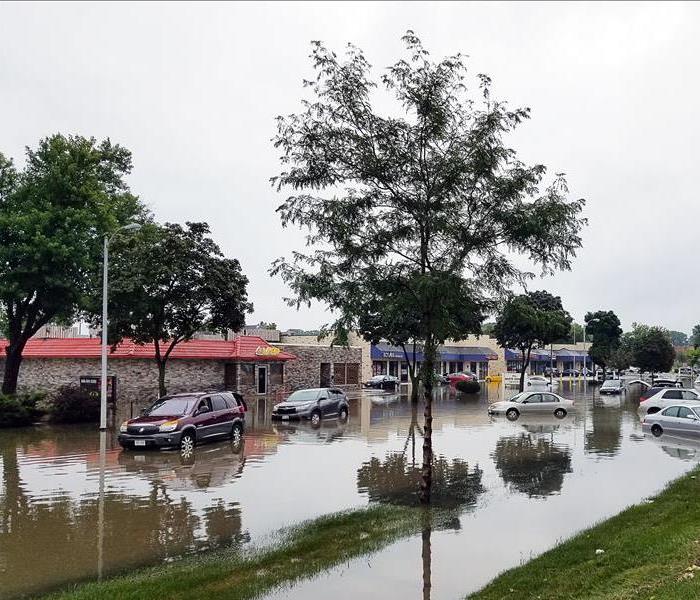 From flooding to sewage, do you know what to do when you have water damages?
From flooding to sewage, do you know what to do when you have water damages?
Do You Need Flood Insurance?
When it comes to water damages in your home, it is usually unexpected. From flooding to sewage, water damages can cause destruction in your home that cost you big time.
You may wonder if purchasing flood insurance for your property is worth it, so here are some things to consider:
- You can request to purchase flood insurance even if you don’t live in a flood plain.
- Ask what your flood insurance includes and how extensive is your coverage. Discuss your coverage with your agent.
- Be aware that not all homeowner’s insurance covers water damage or floods.
- There are different types of water damages and they are not all handled the same.
- If you have been in a natural disaster, you can receive grants from FEMA.
- For more information, read the FAQ here.
Have Questions? Contact Us!
SERVPRO of North Richland Hills specializes in the cleanup and restoration of commercial and residential property after damaging event. Our staff is highly trained in property damage restoration. From initial and ongoing training at SERVPRO’s corporate training facility for regular IICRC-industry certification, rest assured our staff is equipped with the knowledge to restore your property. SERVPRO wants our team to be part of your team! Call us at (817) 363-4177 or follow us on Facebook, Instagram, and Twitter!
How to Conserve More Water at Home
11/14/2018 (Permalink)
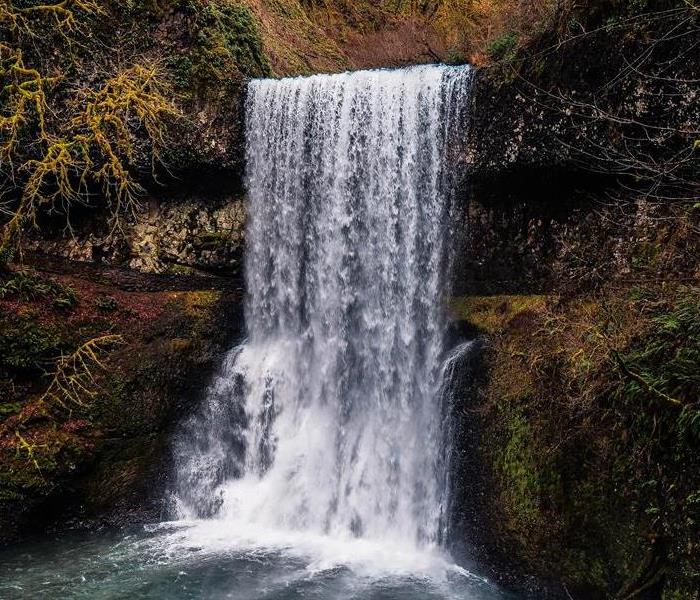 Here are 10 ways to conserve water in your home!
Here are 10 ways to conserve water in your home!
Do you want to conserve more water for the earth (or even just save a few bucks on your water bill)? Check out these 10 simple tips to reuse, reduce, and recycle water in all area of your life!
Saving Water = Saving Money
- Turn off the water while you brush your teeth! One of the simplest ways to conserve water without making any changes to your lifestyle.
- Fix the leaks in your house! Those leaky faucets can waste gallons of water and waste tons of your money.
- Wash your car! That’s right! Instead of DIY, go to a car wash service where they recycle their water! Who knew conserving water could be luxurious?
- Take shorter showers! Did you know that 5 gallons of water go down the drain per a minute? Cutting your shower short by 5 minutes could save you 25 gallons of water!
- Or even try skipping the shower a few days a week. Taking a shower every other day can save you big bucks in the long run!
- Go for a trendy yard! Investing in succulents in your yard will use less water and also gain tons of compliments from your neighbors.
- Run a full dishwasher! Which means you do less dishes while saving more water!
- Do you have a green thumb? Try installing a rain barrel to collect that rain water and put it to good use!
- Or trying watering your plants in the morning! This ensures that water is soaked up in the plants but not evaporated by the sun!
- Even using less electricity can save water. Power plants use water to cool down hot parts, so even turning lights off or unplugging electronics can conserve water in the long run!
Do you have more tips on how to save water? Let us know on our Facebook, Instagram, or Twitter page!
Do You Have Water Damage in Your Home?
SERVPRO of North Richland Hills specializes in the cleanup and restoration of commercial and residential property after damaging event. Our staff is highly trained in property damage restoration. From initial and ongoing training at SERVPRO’s corporate training facility for regular IICRC-industry certification, rest assured our staff is equipped with the knowledge to restore your property. SERVPRO wants our team to be part of your team! Call us at (817) 589-1499 or follow us on Facebook, Instagram, and Twitter!
What To Do When Your Plumbing Bursts?
11/12/2018 (Permalink)
 Don't let a busted pipe ruin your home! Call SERVPRO for fast remediation on any water damages!
Don't let a busted pipe ruin your home! Call SERVPRO for fast remediation on any water damages!
As winter approaches, so does the fear of busted pipes. From frozen pipes to plumbing issues, check out this guide of what to do when your plumbing bursts!
5 Tips to Prevent Plumbing Issues:
- Loud pipes, visible rust, visible moisture on the floor or walls, or wet dirt around home are signs of plumbing issues.
- Don’t forget to let your faucets drip and insulating your pipes to avoid busted pipes.
- Install a leak detection system in your home.
- Installing a backflow system in older homes to prevent sewage backup.
- Never pour grease down a drain! Try pouring it in a jar and then discarding it afterwards.
If you notice that you are having plumbing issues in your home, please call SERVPRO of North Richland Hills to help with your water clean and restoration needs!
SERVPRO of North Richland Hills is Here to Help!
SERVPRO of North Richland Hills specializes in the cleanup and restoration of commercial and residential property after damaging event. Our staff is highly trained in property damage restoration. From initial and ongoing training at SERVPRO’s corporate training facility for regular IICRC-industry certification, rest assured our staff is equipped with the knowledge to restore your property. SERVPRO wants our team to be part of your team! Call us at (817) 589-1499 or follow us on Facebook, Instagram, and Twitter!
24 Hour Emergency Water Damage Services
11/8/2018 (Permalink)
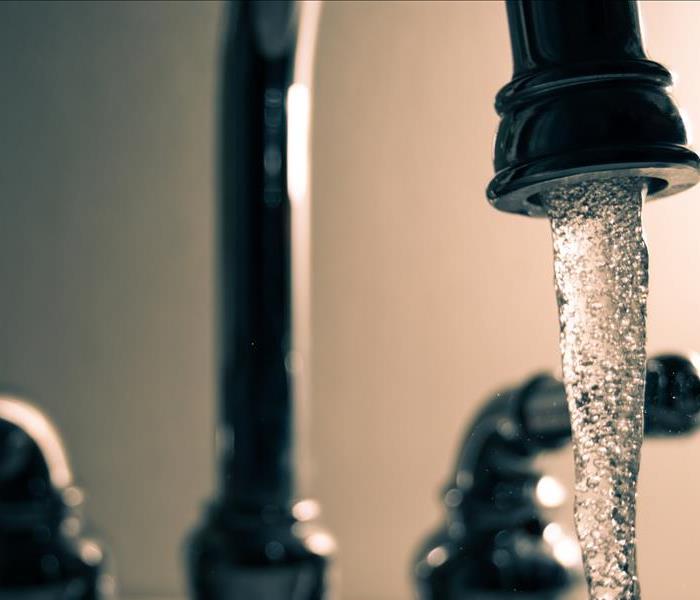 Do you know the source of your water damage?
Do you know the source of your water damage?
SERVPRO of North Richland Hills is here for you 24/7 for all your water emergencies. Our expert teams knows that immediate action important to stop water damage in its track.
We are here to help! In times of confusion, stress, and fear, we understand that you want to trust someone to get the job done right. We specialize in water damage restoration and we want to be able to help your family or business through difficult times.
What You Can Do Now
When you give SERVPRO of North Richland Hills a call, we are going to ask a few questions so we can dispatch our team out to the property quickly. These questions help us understand how to better assist you to our fullest ability.
Our SERVPRO Representative will ask several questions:
- Your name and contact information
- Your insurance information (if applicable)
- The street address of the water-damaged home or business
- When did the flooding or water damage occur?
- What caused the water damage (if known)?
- Is there electricity available (on-site)?
SERVPRO of North Richland Hills is here for whatever you need!
SERVPRO of North Richland Hills specializes in the cleanup and restoration of commercial and residential property after damaging event. Our staff is highly trained in property damage restoration. From initial and ongoing training at SERVPRO’s corporate training facility for regular IICRC-industry certification, rest assured our staff is equipped with the knowledge to restore your property. SERVPRO wants our team to be part of your team! Call us at (817) 589-1499 or follow us on Facebook, Instagram, and Twitter!
Never Underestimate Water Damage
11/8/2018 (Permalink)
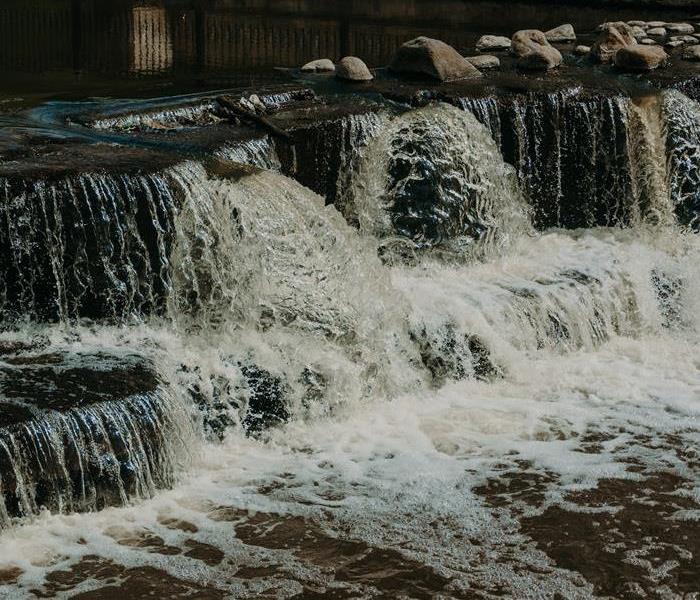 Water damage has many adverse health effects. Here are things that you may need to watch out for!
Water damage has many adverse health effects. Here are things that you may need to watch out for!
Whether big or small, water can affect your home or business in negative ways. When you notice water in parts of your home, call SERVPRO of North Richland Hills to help stop further water damage, find the source, and prevent mold in the future.
What are the Different Effects of Water Damage?
- Mold can start growing after 24-48 hours after water contaminates an area. It is crucial for a fast response to halt mold growth in its track.
- Depending on the water that has contaminated the home or business can cause havoc. Black water is the most contaminated type of water and highly unsanitary.
- Electrical wires or exposed gas lines is dangerous when mixed with water. Make sure to turn off your electricity and gas pipes.
Water damage, whether big or small, can be devastating all around. But calling SERVPRO of North Richland Hills can help the recovery process on your property and we can give you the best option for your home.
SERVPRO of North Richland Hills is Here to Help!
SERVPRO of North Richland Hills specializes in the cleanup and restoration of commercial and residential property after damaging event. Our staff is highly trained in property damage restoration. From initial and ongoing training at SERVPRO’s corporate training facility for regular IICRC-industry certification, rest assured our staff is equipped with the knowledge to restore your property. SERVPRO wants our team to be part of your team! Call us at (817) 589-1499 or follow us on Facebook, Instagram, and Twitter!
What To Do After Your Toilet Overflows
8/16/2018 (Permalink)
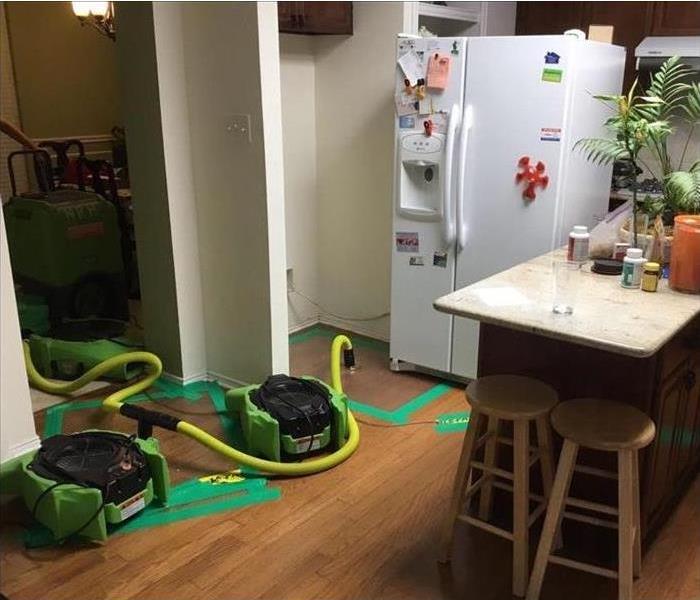 Equipment Set up on a water loss in a North Richland Hills, TX home
Equipment Set up on a water loss in a North Richland Hills, TX home
Indoor plumbing is a wonderful amenity that most of the world has become accustomed to — and very grateful for — but that doesn’t mean it’s a flawless system. Sometimes you’ll find yourself dealing with a flooded toilet, which can be the result of a minor clog or even major sewer damage. No matter what problems you’re experiencing, it’s good to know what to do to minimize the potential damage to your home in North Richland Hills, TX after your toilet spills over.
A Simple Clogged Toilet
Most of the time, the issue is simply a small clog, and you’ll probably be able to take care of it with a plunger. If the toilet is currently overflowing, the first thing you’ll want to do is shut off the water supply using the valve that's usually found just behind the toilet. If you can’t find this, open the water tank and rig the float into a position that allows it to stay in place so no more water flows in.
Any water that made it to the floor is contaminated, especially if it’s from a bigger sewer backup. It’s very important to clean this up and disinfect the area, then disinfect any rags used for the cleanup.
Major Sewer Damage
If it seems like the toilet is still clogged or wants to keep overflowing, there’s a chance the clog is larger and deeper in the pipes. Alternately, there may be damage down below, such as a break or crack in the sewer system.
If you’re experiencing more serious sewer damage, the kind that can't be remedied with a plunger and elbow grease, it will more than likely become worse over time; it is definitely not a problem to put off. Contaminated water can back up not only into your toilets, but also into sinks, bath tubs, and showers, which can become a health hazard for you and your family. Contacting your local sewage system experts to diagnose and fix your sewer problems will give you peace of mind and prevent more costly damage from occurring in your home.
What Do Your Noisy Pipes Mean?
6/22/2018 (Permalink)
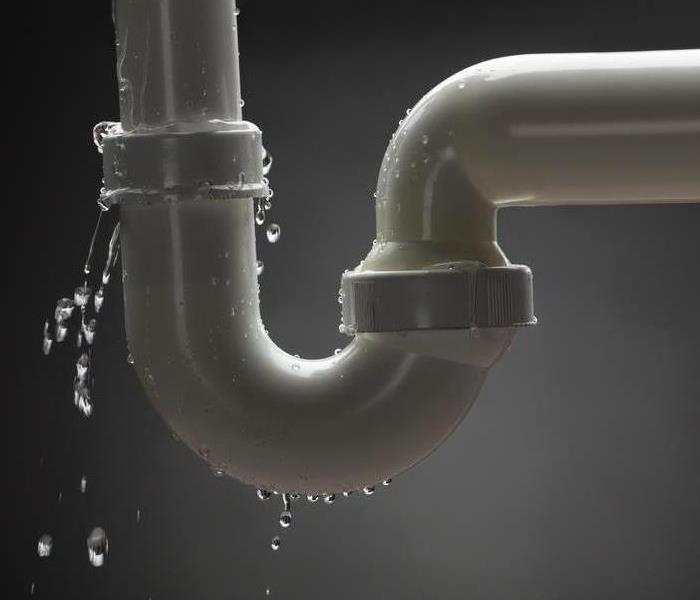 Paying attention to what your plumbing tells you can reduce the chance of needing to call in professionals to fix a broken pipe later down the line.
Paying attention to what your plumbing tells you can reduce the chance of needing to call in professionals to fix a broken pipe later down the line.
Noisy pipes can be startling and headache-inducing in and of themselves, but rattling pipes might also be a sign of a problem with your plumbing. Different noises may indicate different issues. It’s best to seek help in Richland Hills, TX, and get the matter addressed to make sure a minor annoyance doesn’t build up and result in a pipe break. There are a few common noises:
? Whistling
? Banging
? Clanging
Blockage in Pipes
A whistling noise is common in blocked pipes. Blockages are more benign when occurring at faucets, valves and shower heads. Tightening valves, pipe maintenance, and cleaning showerheads can often fix these. A clogged pipe is more serious, however, because the extra pressure is hard on the plumbing and can lead to a pipe break. Professional plumbers are the best solution for blockages in your pipes.
High Water Pressure
High water pressure often comes with a banging or hammering noise. If the noise persists while the water is off, it’s likely being caused by high water pressure. Similar noises may also result from trapped air, which can be resolved by draining pipes to get rid of those air pockets. Water pressure, on the other hand, can result in leaking due to loose pipe connections. If damage from high water pressure goes unaddressed, it can make a pipe burst.
Water Speed Changes
Water speed changes are likely the cause if there is a clanging noise whenever a faucet or shower is shut off. The clanging noise comes from the pipe vibrating at the change in the water’s speed. The change in momentum can be normal but on rare occasions can cause pipe connections to loosen or leak. Anti-hammer devices can help with this problem.
Paying attention to what your plumbing tells you can reduce the chance of needing to call in professionals to fix a broken pipe later down the line. The inconvenience of a pipe break can be avoided in many cases simply by doing regular maintenance. For more information, visit http://www.SERVPROnorthrichlandhills.com/.
When Water Damage Strikes
3/13/2018 (Permalink)
The first 24 hours following a water loss are the most important in preventing secondary or permanent damage. Within four hours of loss notification, SERVPRO of North Richland Hills will have a Professional on-site to help ensure the water damage is handled by completing the following steps.
SERVPRO Professionals will inspect affected areas to determine the extent of water damage and will review the inspection with you to answer any questions before beginning any work.
SERVPRO Professionals will take steps to help protect your home or business, as well as personal belongings and other contens, from further damage by extracting the excess water and preparing the area for for drying. They will explain the needed emergency services to you step-by-step
To help ensure your home or business
and belongings are dried to appropriate
industry standards, a SERVPRO Professional will monitor the drying process. The updates will be
consistently communicated to you.
SERVPRO Professionals will repair structural materials, reinstall carpets, and clean affected areas of your property and belongings. A final walk-through of the job-site will be conducted
with you to help ensure the property was returned to preloss condition.
We Answer the Phone Ready to Help 24/7
Call Today - 817-589-1499
24 Hour Emergency Water Damage Service
11/17/2017 (Permalink)
SERVPRO of North Richland Hills is available 24 hours a day for water emergencies, large or small. When you are dealing with water damage, immediate action is crucial. A delay of just a few hours can greatly increase the severity of the water damage.
We Answer the Phone Ready to Help
Call Today - 817-589-1499
We understand that when you call us, you may be feeling confused, stressed, and vulnerable. You need an expert to guide you through this crisis. SERVPRO of North Richland Hills has the specific water damage training and experience to help you through this tough time. We specialize in water damage restoration—in fact, it's the cornerstone of our business.
What to Expect
When you call, we will ask several questions regarding your water damage emergency. These questions will help us determine what equipment and resources to bring, including how many trained SERVPRO Professionals may be needed.
Our SERVPRO Representative will ask several questions:
- Your name and contact information
- Your insurance information (if applicable)
- The street address of the water-damaged home or business
- When did the flooding or water damage occur?
- What caused the water damage (if known)?
- Is there electricity available (on-site)?
About SERVPRO of North Richland Hills
SERVPRO of North Richland Hills specializes in the cleanup and restoration of residential and commercial property after a fire, smoke or water damage event. Our staff is highly trained in property damage restoration. From initial and ongoing training at SERVPRO’s corporate training facility to regular IICRC-industry certification, rest assured our staff is equipped with the knowledge to restore your property.
24 Hour Emergency Water Damage Service
11/17/2017 (Permalink)
SERVPRO of North Richland Hills is available 24 hours a day for water emergencies, large or small. When you are dealing with water damage, immediate action is crucial. A delay of just a few hours can greatly increase the severity of the water damage.
We Answer the Phone Ready to Help
Call Today - 817-589-1499
We understand that when you call us, you may be feeling confused, stressed, and vulnerable. You need an expert to guide you through this crisis. SERVPRO of North Richland Hills has the specific water damage training and experience to help you through this tough time. We specialize in water damage restoration—in fact, it's the cornerstone of our business.
What to Expect
When you call, we will ask several questions regarding your water damage emergency. These questions will help us determine what equipment and resources to bring, including how many trained SERVPRO Professionals may be needed.
Our SERVPRO Representative will ask several questions:
- Your name and contact information
- Your insurance information (if applicable)
- The street address of the water-damaged home or business
- When did the flooding or water damage occur?
- What caused the water damage (if known)?
- Is there electricity available (on-site)?
About SERVPRO of North Richland Hills
SERVPRO of North Richland Hills specializes in the cleanup and restoration of residential and commercial property after a fire, smoke or water damage event. Our staff is highly trained in property damage restoration. From initial and ongoing training at SERVPRO’s corporate training facility to regular IICRC-industry certification, rest assured our staff is equipped with the knowledge to restore your property.
Water Damage Timeline and the Effects
11/17/2017 (Permalink)
Flooding and water emergencies don’t wait for regular business hours and neither do we. SERVPRO of North Richland Hills provides emergency cleaning and restoration services 24 hours a day, 7 days a week—including all holidays.
Faster To Any Size Disaster
Flooding and water damage is very invasive. Water quickly spreads throughout your home and gets absorbed into floors, walls, furniture, and more. SERVPRO of North Richland Hills arrives quickly and starts the water extraction process almost immediately. This immediate response helps to minimize the damage and the cleaning and restoration costs.
Need Emergency Service? Call Us 24/7 817-589-1499
Water Damage Timeline
Within Minutes
- Water quickly spreads throughout your property, saturating everything in its path.
- Water is absorbed into walls, floors, upholstery, and belongings.
- Furniture finishes may bleed, causing permanent staining on carpets.
- Photographs, books, and other paper goods start to swell and warp.
Hours 1 - 24:
- Drywall begins to swell and break down.
- Metal surfaces begin to tarnish.
- Furniture begins to swell and crack.
- Dyes and inks from cloth and paper goods spread and stain.
- A musty odor appears.
48 Hours to 1 Week:
- Mold and mildew may grow and spread.
- Doors, windows, and studs swell and warp.
- Metal begins to rust and corrode.
- Furniture warps and shows signs of mold.
- Paint begins to blister.
- Wood flooring swells and warps.
- Serious biohazard contamination is possible.
More Than 1 Week:
- Restoration time and cost increase dramatically; replacing contaminated materials and structural rebuilding may be extensive.
- Structural safety, mold growth, and biohazard contaminants pose serious risks to occupants.
About SERVPRO of North Richland Hills
SERVPRO of North Richland Hills specializes in the cleanup and restoration of residential and commercial property after a fire, smoke or water damage event. Our staff is highly trained in property damage restoration. From initial and ongoing training at SERVPRO’s corporate training facility to regular IICRC-industry certification, rest assured our staff is equipped with the knowledge to restore your property.
Water Damage Timeline and the Effects
11/17/2017 (Permalink)
Flooding and water emergencies don’t wait for regular business hours and neither do we. SERVPRO of North Richland Hills provides emergency cleaning and restoration services 24 hours a day, 7 days a week—including all holidays.
Faster To Any Size Disaster
Flooding and water damage is very invasive. Water quickly spreads throughout your home and gets absorbed into floors, walls, furniture, and more. SERVPRO of North Richland Hills arrives quickly and starts the water extraction process almost immediately. This immediate response helps to minimize the damage and the cleaning and restoration costs.
Need Emergency Service? Call Us 24/7 817-589-1499
Water Damage Timeline
Within Minutes
- Water quickly spreads throughout your property, saturating everything in its path.
- Water is absorbed into walls, floors, upholstery, and belongings.
- Furniture finishes may bleed, causing permanent staining on carpets.
- Photographs, books, and other paper goods start to swell and warp.
Hours 1 - 24:
- Drywall begins to swell and break down.
- Metal surfaces begin to tarnish.
- Furniture begins to swell and crack.
- Dyes and inks from cloth and paper goods spread and stain.
- A musty odor appears.
48 Hours to 1 Week:
- Mold and mildew may grow and spread.
- Doors, windows, and studs swell and warp.
- Metal begins to rust and corrode.
- Furniture warps and shows signs of mold.
- Paint begins to blister.
- Wood flooring swells and warps.
- Serious biohazard contamination is possible.
More Than 1 Week:
- Restoration time and cost increase dramatically; replacing contaminated materials and structural rebuilding may be extensive.
- Structural safety, mold growth, and biohazard contaminants pose serious risks to occupants.
About SERVPRO of North Richland Hills
SERVPRO of North Richland Hills specializes in the cleanup and restoration of residential and commercial property after a fire, smoke or water damage event. Our staff is highly trained in property damage restoration. From initial and ongoing training at SERVPRO’s corporate training facility to regular IICRC-industry certification, rest assured our staff is equipped with the knowledge to restore your property.
When A Water Damage Occurs
6/19/2017 (Permalink)
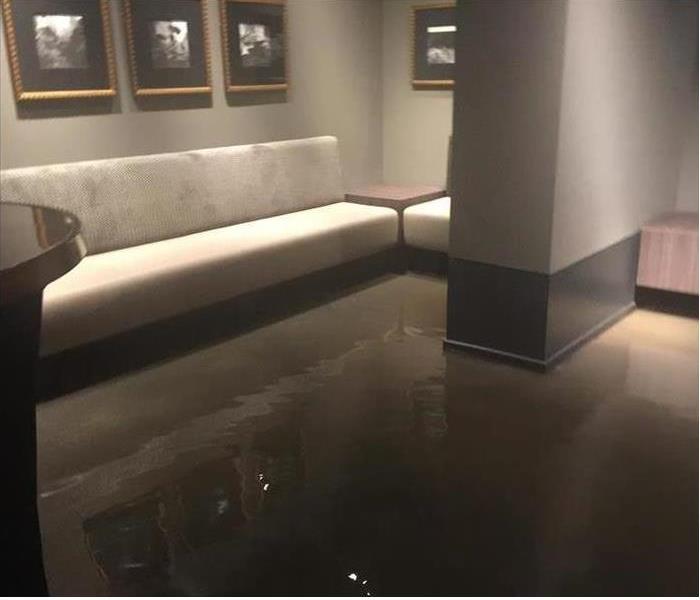 Be Prepared When a Water Damage Occurs!
Be Prepared When a Water Damage Occurs!
SERVPRO of North Richland Hills provides 24-hour fire and water damage restoration service in Tarrant County
Our highly trained SERVPRO of North Richland Hills team is available 24 hours a day for water emergencies, large or small. When you are dealing with water damage, immediate action is crucial. A delay of just a few hours can greatly increase the severity of the water damage.
We Answer the Phone Ready to Help
Call Today - 817-589-1499
We understand that when you call us, you may be feeling confused, stressed, and vulnerable. You need an expert to guide you through this crisis. SERVPRO of North Richland Hills has the specific water damage training and experience to help you through this tough time. We specialize in water damage restoration—in fact, it's the cornerstone of our business.
What to Expect.
Our SERVPRO Representative will ask several questions to help us determine what equipment and resources to bring, including how many trained SERVPRO Professionals may be needed.:
- Your name and contact information
- Your insurance information (if applicable)
- The street address of the water-damaged home or business
- When did the flooding or water damage occur?
- What caused the water damage (if known)?
- Is there electricity available (on-site)?
About SERVPRO of North Richland Hills
SERVPRO of North Richland Hills specializes in the cleanup and restoration of commercial and residential property after a water damage event. Our staff is highly trained in property damage restoration. From initial and ongoing training at SERVPRO’s corporate training facility to regular IICRC-industry certification, rest assured our staff is equipped with the knowledge to restore your property.
Call SERVPRO of North Richland Hills at 817-589-1499.
Do You Have an Emergency Ready Plan? If not let SERVPRO of North Richland Hills prepare one for you at no charge.
Tips on Preventing a Water Damage
4/18/2017 (Permalink)
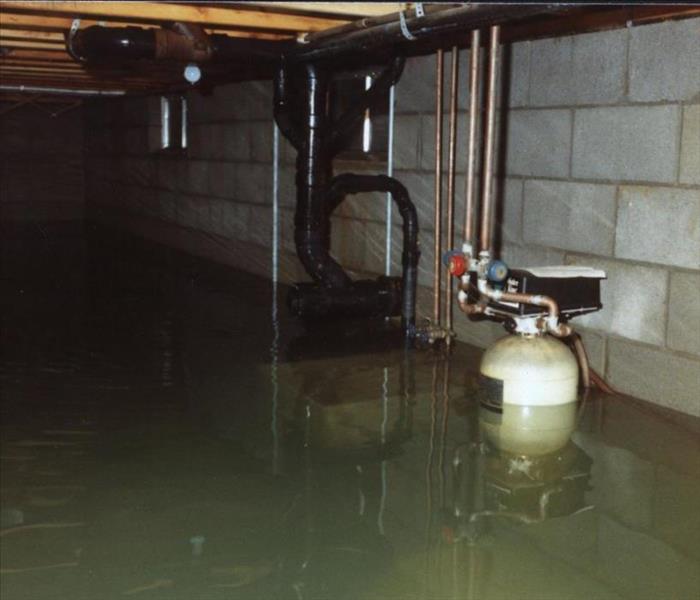 Commercial Water Damage
Commercial Water Damage
Water damage to your home or business can happen at any time, day or night. There are numerous sources that can cause a water damage such as leaky bathrooms, broken pipes, rainwater, faulty washing machine hoses, refrigerator ice lines and frozen pipes. We have put together a few tips that may help you prevent a water damage from happening. Knowledge is the best policy to help you prevent loss.
Putting a stop on leaks, drips and clogs
- Make sure to turn off the water supply before you leave for an extended length of time.
- Check the seal and caulking in your shower and tub area a few times per year to make sure there is no cracking or discoloration. If cracking and discoloration is noticed, it’s time to replace your caulking.
- Washing Machine: Check your washing machine hose every 3 to 6 months. Look for cracks, leaks and check to see if it looks brittle or deteriorated. If any signs are found you should replace hose immediately.
- If you plan to be away from your home or business for an extended length of time, it is a good idea to shut off the water supply to your washing machine, toilets, sinks and refrigerator.
- Icemaker: Inspect your ice maker line for cracks or leaks. If there is inflexibility or discoloring, this can lead to a burst or broken line. You should have this replaced immediately
- It is a good idea to inspect and replace all worn fittings and hose connections to all household appliances that use water.
Protecting pipes in the winter:
- Shut off and drain the water supply to outside faucets and detach and drain all gardening hoses.
- Wrap pipes located nearest exterior walls with pipe insulation or heating tape.
- Let faucets drip to prevent pipes from freezing. If a pipe bursts, turn off the main water supply and leave the faucet open until repairs are completed.
- When away from home in the lower temperatures, be careful how much you lower the heat. There could be a disaster if a cold spell strikes.
Everyone knows that if you are a home or business owner, chances are that you or someone you know will experience some type of water damage. So, the questions is not if this will happen to you or someone you know, but how you will handle the situation when a disaster strikes?
When your home or business is under water, every minute counts! Our highly trained SERVPRO of North Richland Hills team is ready to respond quickly, professionally and efficiently to your water loss 24 hours a day, 7 days a week! Call SERVPRO of North Richland Hills at 817-589-1499 or visit our website at http://www.SERVPROnorthrichlandhills.com.
Tips for Preventing Air Conditioner Water Damage
4/17/2017 (Permalink)
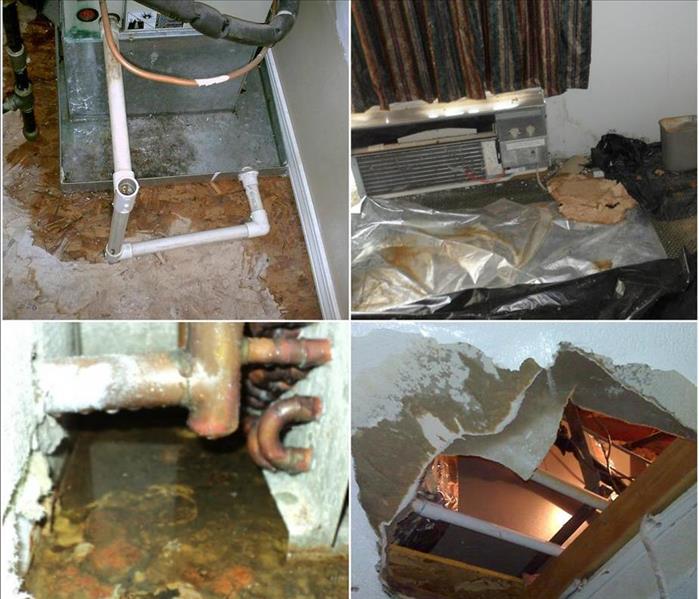 Water Damage Caused By Air Conditioners
Water Damage Caused By Air Conditioners
Summer is right around the corner and that means 100-degree weather if you live in Texas and air conditions running all day and night. While most people enjoy keeping their home or business cool and comfortable indoors throughout summer they don’t realize that air conditioners can sometimes cause a water damage if not properly maintained.
Did you know an air conditioning system can collect 10 to 20 gallons of water daily when working at peak efficiency? Normally the water will drain off the condensation coil into a collection pan and then is disposed of automatically into the sewer system but if the drain becomes clogged and the unit produces more water than it can handle, the water will overflow and can lead to damaged floors and carpeting. If not noticed it can also cause mold growth.
Although a clogged drain line is often the major source of creating water damage there are other causes such as excessive condensation that occurs when the unit is running round the clock in addition to evaporator coils that may freeze up and then defrost on a regular basis. Because most of the unit is typically hidden from view water damage can be occurring daily and accumulating into hundreds of dollars’ worth of damage.
1.Make sure to change the air filter every month. By changing the air filter monthly, it gives you the opportunity to check whether there is excessive moisture collecting on the condensation line. Making sure that the AC unit has clean air filters also helps prevent the unit from overworking and causing freezing and then defrosting on the evaporator coils, leading to water damage.
2. It is important to regularly check to see that water is indeed flowing from the opening of the condensation line directly to the drain as it was designed to do, especially during periods of very high humidity in the atmosphere.
3. When installing an AC condensation line, avoid using elbow connections if possible and have the line run in as straight an up and down direction as possible to facilitate water removal from the unit.
4. Consider having a professional air conditioning repair service to clean the condensation line at least once a year or every six months if the AC system is used on a year-round basis. A professional plumbing service can also install a condensation pump to help ensure the free flow of excess water into the proper disposal drain. A repair technician may recommend installing a device known as a safety float switch which will automatically shut down the power to an AC unit whenever condensation builds up and there is a danger of water overflow.
By following the four steps listed, you can help reduce the chances of water damage. If a water damage does occur SERVPRO of North Richland Hills is ready to help get your home or business dry. Call us at 817-589-1499 or go to our website at www.SERVPROnorthrichlandhills.com
Ways to Help Prevent Water Damage
11/16/2016 (Permalink)
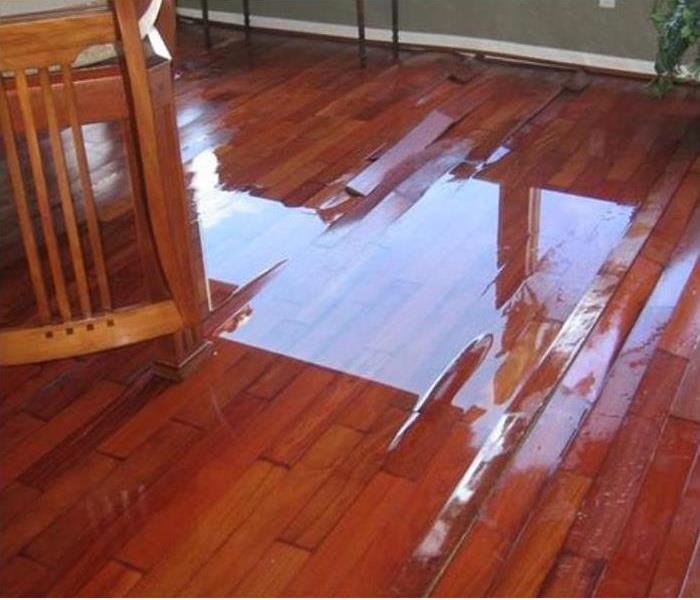 Water Damaged Wood Floors at a Luxury Downtown Fort Worth, Texas Condo.
Water Damaged Wood Floors at a Luxury Downtown Fort Worth, Texas Condo.
A water damage can cause a home or business owner thousands of dollars in damage in just a matter of hours! The good news is you can prevent water damage to your home by following a few simple, inexpensive preventative measures.
- Make Sure You Clean the Gutters - Gutters and downspouts should be cleaned at least once a year – even more often if you have overhanging trees dropping leaves and debris. Gutters that become clogged can dump water down the side of your house, destroying plants, landscaping and your home’s foundation. Installing gutter covers is a good way to slow clogging. Making sure the gutters are clean is a simple way to allow the gutters to do their job, and to let water harmlessly drain away.
- Monitor Your Water Bill & Water Meter - A spike in your water bill could indicate a leak. Even a small leak can become a big problem if left unattended for a long period. To check for leaks you can't see, try marking the water meter with a piece of masking tape (or note the digital reading), with the edge right over the needle to mark its place. Provided all water-using devices and faucets are turned off, the next step is to leave the house for 6 hours. Upon returning, the needle should be in the exact same spot. If it has moved at all, there most likely is a leak.
- Check Under Your Kitchen & Bathroom Sink -Kitchen & bathroom sinks, are among the most used drains in the home. Sink drain pipes develop leaks particularly since they are in common spaces and typically near under-sink storage. If the sink has gotten jostled and not properly resealed, it can begin damaging the cabinet space underneath. Be sure to remove items from under your kitchen sink occasionally to check for dampness and mildew. If left untreated, this can result in both significant mold and more serious damages to the home.
- Flash and Chalk Windows and Doors - Windows and doors are the main openings in a home, and often the spaces around their frames develop cracks where water can seep in. To prevent water getting into the walls, ensure that the flashing and caulking that surrounds these openings is intact. It is recommended that you caulk doors and windows at least every five years, and inspect them every time the season changes. For homes that have vertically-mounted vents that lead into the attic from a wall instead of through the roof, the same maintenance process also applies to these vents.
- Turn Off Water When Leaving - It’s always a good idea to turn off the main water supply when leaving your home for an extended period. Turning off the main water supply helps to reduce the chance of small leaks turning into huge, expensive damage while you are away. Never run appliances, such as your dishwasher and washing machine while you are away from home. If the appliance leaks while you are gone, the damage can be tremendous. Finally, know the location of your main water supply valve and learn how to shut it off before you have a leak.
- Secure Appliances and Fixtures - Supply lines for ice makers, toilets and washing machines are often subject to vibration and can loosen. Over time supply lines can wear out and begin to leak. It is recommended that you replace any rubber supply lines with braided stainless steel. Installing a leak detector with a water-sensitive shut-off mechanism can also prevent flooding in your home. You should inspect the tightness of connections at least every 6 months. If there is fraying, replace the line immediately.
- Inspect Your Air Conditioning Unit - It is very important that you check for water overflow during the hot summer months when your air conditioner is running constantly. If you notice water leaking from your AC inside, it could be due to a clogged condensate drain line. When the water cannot escape your home through the soffit hose, it fills the drain pan and overflows. It is also important to make sure that the drain pan is not old and damaged. If you do have a leak it’s best to call a professional to determine the reason for the leak.
- Know When to Replace Your Hot Water Heater - The average lifespan of a hot water heater is 8-12 years. As your heater ages, it’s prone to slow leaks and sudden bursts, due to tank corrosion and broken valves. If you notice the water doesn’t get as hot as it used to, there’s rust in your water or a metallic taste to your hot water, it could be a sign your hot water heater is about to fail. Schedule a professional inspection immediately.
SERVPRO of North Richland Hills is available 24 hours a day, 7 days a week, 365 days a year for water emergencies, large or small. When you are dealing with water damage, immediate action is crucial. A delay of just a few hours can greatly increase the severity of the water damage.
We Answer the Phone Ready to Help
Call Today - 817-589-1499
Tips for Preventing Your Pipes from Freezing
11/16/2016 (Permalink)
 Frozen pipe busted in Downtown Fort Worth commercial building.
Frozen pipe busted in Downtown Fort Worth commercial building.
Winter is finally on its way here, and so is freezing temperatures that could cause frozen pipes. Plumbing breaks and flood damage can be incredibly costly, so being prepared is very important when it comes to keeping your pipes from freezing. Following these easy steps to prevent your pipes from freezing can help prevent expensive plumbing repairs.
Water Main: Locate your house’s water main shut-off valve. In case of a water emergency, you will need to shut off all water flow to the home, and this time-saving knowledge could save you thousands in case of a burst pipe.
Exterior Pipes: Locate all outdoor spigots and unhook, drain and store all your hoses, covering your spigots with insulated spigot sleeves. Locate all other exterior pipes like swimming pool supply lines, water sprinkler lines and any other exposed pipes running along exterior walls of your home. On these, install insulated pipe sleeves that slip right over the pipes. You can find these at any home supply store, but you can also use bubble wrap, a towel or a blanket to help protect these pipes.
Attic, Basement and Crawl Space Pipes: Install pipe sleeves on both cold and hot water pipes in attics, basements and crawl spaces. You can also put in regular fiberglass insulation, or you can install a heat lamp in crawl spaces and cold basements. However, never leave heat lamps or heaters unattended for too long, and don’t allow them to get too hot or near combustible materials that could catch fire.
Cold Air Entry Points: Walk around the perimeter of your home and locate all the foundation and attic vents. Then simply cut foam board insulation to fit in these vents and pop them in. This will help keep cold air out and keep the warm air in. For larger areas, such as attic peaks, install larger foam board insulation from the interior side. With caulk, seal all air leaks around the foundation or other places in your home that could be allowing in cold air, such as electrical wiring, dryer vents or pipe entry points.
Prevention Tips:
- When you know that temperatures will be dipping below freezing, simply allow water to run in all the sinks at a slow, constant drip. It only needs to trickle, and that tiny amount of water will keep the water moving through the pipes and prevent them from freezing.
- Open the cabinet doors in the bathrooms and kitchen. This will allow the heat from the home to circulate and warm up the pipes.
- Keep the garage door closed to keep garage pipes from freezing.
- Keep your house at a warm, consistent temperature both day and night.
- If you leave your home for extended periods of time, do not set your thermostat lower than 55 decrees.
- If you do end up with frozen pipes, a hand-held hair dryer or heat lamp can thaw them.
SERVPRO of North Richland Hills is available 24 hours a day, 7 days a week, 365 days a year for water emergencies, large or small. When you are dealing with water damage, immediate action is crucial. A delay of just a few hours can greatly increase the severity of the water damage.
We Answer the Phone Ready to Help
Call Today - 817-589-1499
Sewage Backup
2/29/2016 (Permalink)
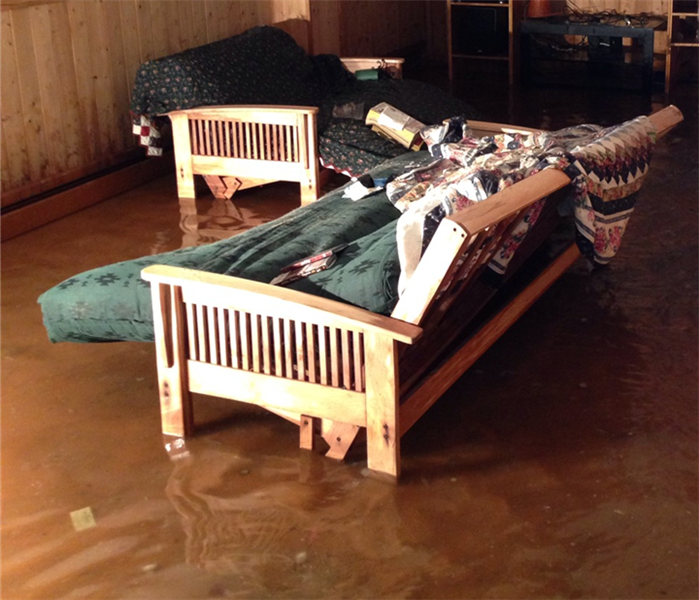 Sewage backup in a house. Water extraction was first step in mitigating this loss followed by removing all porous materials that were affected.
Sewage backup in a house. Water extraction was first step in mitigating this loss followed by removing all porous materials that were affected.
It's one of the worst pluming problems anyone can experience - sewage backups. Sewage backups can enter your home or business from many sources: pipe breaks or cracks due to tree roots, grease accumulation, hair, system deterioration, and items such as disposable diapers or sanitary napkins that are too large for waste water pipes to handle Sewage is extremely harmful to your health. Because of it's contaminants, viruses, and bacteria, you can become very ill if sewage is not cleaned up properly.
Time is of the essence when you experience any type of water damage to your business or home. Many times the water or moisture that you can not see becomes the issue. For example, water can seep from the floor and behind the baseboard attached to the drywall. If not properly detected and dried further damage can occur leading to secondary damage.
If you notice any signs of a sewage backup in your home or business, call the professionals at SERVPRO. We specialize in properly cleaning, disinfecting and deodarizing your structure.
Call SERVPRO (817) 589-1499 or visit us at http://www.SERVPROnorthrichlandhills.com/biohazard-cleaning




 24/7 Emergency Service
24/7 Emergency Service


































